ED Response to 60 day Public Comments
IPEDS 2019-20 through 2021-22 Response to 60-day Public Comments.docx
Integrated Postsecondary Education Data System (IPEDS) 2019-20 through 2021-22
ED Response to 60 day Public Comments
OMB: 1850-0582
Public Comments Received During the 60-day Comment Period and NCES Responses
June 2019
Integrated Postsecondary Education Data System (IPEDS) 2019-20 through 2021-22
ED-2019-ICCD-0028 Comments on FR Doc # 2019-05241
Dear all who submitted a comment:
Thank you for your feedback responding to a request for comments on proposed changes to the Department of Education’s Integrated Postsecondary Education Data System (IPEDS) 2019-20 through 2021-22. The National Center for Education Statistics (NCES) appreciates your interest in IPEDS. The Paperwork Reduction Act (PRA) provides an opportunity for an open and public comment period where comments on collections can be made. We are grateful for this process and your comment. Please see responses to your specific comments below.
Comment on the IPEDS data collection – Academic Libraries Staffing and Electronic Circulations (Comment # 6)
Document number: ED-2019-ICCD-0028-0006
Name: Tracey Mendoza
Date posted: March 25, 2019
Changes suggested for Academic Libraries will help understand staffing levels. Would like to see a return to the ratio of librarians to students as there is one for faculty / instructional staff to students.
Changes suggested in other areas such as electronic circulation are also welcomed
Response – Academic Libraries Staffing and Electronic Circulations (Comment # 6)
Dear Tracey Mendoza,
Thank you for submitting your comments in support of changes to staffing and electronic circulation counts to the Academic Library (AL) survey. In response to your comment on a ratio of librarians to students, NCES plans to work with the Association of College and Research Libraries (ACRL) and Association of Research Libraries (ARL) Joint Advisory Task Force on IPEDS/AL Component to provide a calculated derived variable in the datacenter on the IPEDS’s “Use the Data” webpage to account for this ratio when the data are released from the 2020-21 data collection.
Thank you for submitting your comment
Thank you again for your feedback.
Sincerely yours,
Samuel F. Barbett
Acting Postsecondary Branch Chief
Administrative Data Division
Comment on the IPEDS data collection - General (Comment # 7)
Document number: ED-2019-ICCD-0028-0007
Name: Thomas Kenny
Date posted: March 25, 2019
(1) Is this collection necessary to the proper functions of the Department;
I do not believe that IPEDS data is necessary for proper functioning of the US Department of Education as it works towards its stated objective: "Our mission is to promote student achievement and preparation for global competitiveness by fostering educational excellence and ensuring equal access." I have never seen IPEDS data used to improve the quality of education offerings and do not believe it impacts access to education one way or the other.
(2) will this information be processed and used in a timely manner;
I do not believe the information will be processed and used in a timely manner. The information collected is typically on obscure cohorts of students from many years ago and is irrelevant to current students by the time it's collected and published. Furthermore, I do not believe this data is regularly used by schools or their students. Students don't even know that this information is available, nor would they know what to do with the data if they did look it up in the first place because it's difficult to interpret and ultimately not actionable. Instead, it mostly just sits there.
(3) is the estimate of burden accurate;
I do not believe the estimate of time burden is accurate. The estimates presume that all schools possess a student information system and HR information system that are tailored to fit IPEDS reports. Most software companies charge an excessive amount to create these custom reports and otherwise the time burden of reporting is much longer.
(4) how might the Department enhance the quality, utility, and clarity of the information to be collected; and
I believe that the Department should survey students about what information they would find helpful for screening school options. I believe that schools would benefit most by relying upon their own historical data trends and comparing basic data sets that students request from different schools.
(5) how might the Department minimize the burden of this collection on the respondents, including through the use of information technology.
The biggest source of the burden comes from trying to manually compile data and/or use data from both legacy and current software systems. Additionally, when new information than was previously disclosed is requested about a cohort of students from 5+ years ago, it's almost impossible to find a report that has the relevant data. I don't know how the logistics would work to have the Department create sample reports and work with major software vendors to ensure the reports are feasible based on industry-standard data collection processes. Then they should make sure major vendors have established data collection to support generating these reports for current and future cohorts and not go backward with such collections.
Response - General (Comment # 7)
Dear Thomas Kenny,
In regard to the Department’s mission (https://www2.ed.gov/about/overview/mission/mission.html), there are several aspects to the overarching mission which also includes “Promote improvements in the quality and usefulness of education through Federally supported research, evaluation, and sharing information” and “Increase the accountability of Federal education programs to the President, the Congress, and the public”. These two aspects of the mission are heavily data-driven and require statistical metrics to inform the Department’s stakeholders and taxpayers that their financial and political support are helping the students of America. NCES would like to take this opportunity to illustrate how the IPEDS data collection fits clearly in the Department’s mission.
The IPEDS data are collected by the National Center for Education Statistics (NCES), which is the primary federal entity for collecting and analyzing data related to education in the U.S. and fulfills a Congressional mandate to collect, collate, analyze, and report complete statistics on the condition of American education; conduct and publish reports; and review and report on education activities. A majority of the data collected by the IPEDS are required by law; more information about the origin of IPEDS items can be found in the publication “The History and Origins of Survey Items for the Integrated Postsecondary Education Data System (2016–17 Update)”, available at https://nces.ed.gov/pubs2018/NPEC2018023.pdf.
While there is no itemized account of who uses the IPEDS data, the Department recognizes a variety of users – from students, parents, counselors, policy makers at the local, state, and federal levels; institutions of higher education; higher education associations; think-tank researchers; and the press regularly reach out to NCES for IPEDS data. IPEDS data also serve as the sampling frame for the NCES sample surveys that answer questions about college costs, debt, and post college activities. NCES strives to maintain a timely release of accurate data so that these stakeholders have access to the most up to date information about higher education. For example, NCES receives many questions about student graduation and completions. The Graduation Rate cohorts that are reported, which are legally required and specified by the Student Right to Know and Campus Security Act of 1990, include students that completed within the most recent academic year, and the timeframes are based on the expected timeframes for students to complete (within 150%). The Outcome Measures cohorts, which were created to address the postsecondary industry’s request to provide alternative measures of student success, reflect an expanded depiction of graduation rates (especially for the 2-year sector) through the inclusion of part-time and transfer students, who are a growing population that have been largely ignored through the focus on first-time, full-time undergraduate students. Both Graduation Rates and Outcome Measures provide the most complete picture of student completion at an institution while not overburdening institutions.
All burden estimates are based on the responses to the burden questions at the end of each survey component. Institutions have the option of reporting their time burden to NCES. Based on reported data, NCES calculates the burden estimates to reflect the industry burden. In 2017, NCES recalibrated its burden questions, which went through a rigorous cognitive interview evaluation of with a sub-sample of institutions that report to IPEDS.
Students have multiple ways of gathering college information and some may not feel comfortable reaching out to individual institutions for more information. While IPEDS data do not cover all areas of interest for students, which vary greatly from student to student, the College Navigator, which not only presents IPEDS data but also Veteran Affairs and Federal Student Aid cohort default rates, can be one of many college resources for students’ college choice. IPEDS serves to inform students to narrow their search and reach out to a smaller number of institutions. Additionally, it allows institutions to compare themselves to peer institutions across the U.S. and its territories versus requesting data on a student by student request basis.
Finally, NCES makes clear to the public the legal requirements for reporting that extend beyond five years, and institutions that receive Title IV student aid from the federal government, which provides access to students, are expected to understand the requirements and report to IPEDS. Major vendors are also aware of reporting requirements, since all requirements are in the public space.
Thank you for taking the time to provide comment.
Sincerely Yours,
Samuel F. Barbett
Acting Postsecondary Branch Chief
Administrative Data Division
Comment on the IPEDS data collection – Certificates, Human Resources – SOC, and Duplicative Data (Comment # 8)
Document number: ED-2019-ICCD-0028-0008
Name: Michael Lane
Date posted: March 26, 2019
Comments for proposed changes to IPEDS 2019-20 though 2021-22. Comments are my own and may or may not represent the views of my employer.
Subbaccalaureate certificates: one concern I have here is how our accrediting body is going to treat "new" levels appearing in IPEDS. In the past any new level offered by the institution required a Substantive Change. Has there been any outreach to accrediting bodies for their feedback?
Human Resources: I believe reporting by occupational category has significant value and does not add very much to the burden because most institutions, I believe, will have already classified their employees. This data has particular value when looking at trends in various employment categories over time. This can be particularly useful when an institution has undergone a systems change and may have lost older data. In that case their IPEDS submission may be the only good source of their employment in prior years by occupational category. The changes to occupational categories have already made it rather difficult to do comparisons to prior years. Lumping everything into management or non-management would reduce the value so much it may not even be worth reporting.
Duplicative Federally Reported Data: Nothing significant that I'm aware is being reported multiple times to Federal agencies. I'm not sure why this came up. I've been doing this work for a long time and I can't think of a single significant case where IPEDS data is reported multiple times to the Federal government more than once.
Response – Certificates, Human Resources – SOC, and Duplicative Data (Comment #8)
Dear Michael Lane,
NCES is adding the new level based on feedback from the National Postsecondary Education Cooperative (NPEC) and TRP #52, Subbaccalaureate Certificates. The findings of the TRP were made public and were open for public comment, including to comments from accrediting bodies. In addition, this OMB clearance process is open to the public comment, including comments from accrediting bodies. Using the NPEC and TRP panels, NCES decided to add this new level to differentiate certificates of less than one year, however, it is important to note that this will not require institutions to add a program, they will just need to separate their less than one year certificates based on their hours; thus, there is no need for a substantive change.
After receiving feedback from other federal agencies and postsecondary institutions, NCES determined that it is necessary to include SOC codes in the HR component. NCES provides these data to other federal agencies to meet required reporting requirements, which impede IPEDS ability to currently remove these reporting measures from the collection. IPEDS will continue to evaluate other options available to reduce reporting burden for the HR component and across all IPEDS surveys. However, the IPEDS’s HR survey will not currently incur any changes from that of the 2018-2019 collection.
Finally, thank you for your comment related to burden. NCES wants to ensure that it is investigating all opportunities for reducing undue burden on institutions, and feedback such as yours is helpful in understanding that NCES is collecting unique data.
Thank you for taking the time to provide comment.
Sincerely Yours,
Samuel F. Barbett
Acting Postsecondary Branch Chief
Administrative Data Division
Comment on the IPEDS data collection – Burden (Comment #9)
Document number: ED-2019-ICCD-0028-0009
Name: Joe Stankovich
Date posted: March 26, 2019
I will focus on #5 here - "How might the Department minimize the burden of this collection on the respondents, including through the use of information technology?" Has the department ever done an audit of how often data from each IPEDS survey is used (publications, journals, etc) and/or access (eg, via IPEDS Use The Data, etc)? I have to believe that certain surveys are accessed/used much less often (perhaps Libraries, etc) than others (perhaps Fall Enrollment, etc). I know usage may not mean that an area or question is unimportant, but I firmly believe that the Dept of Ed needs to start thinking about what can be removed from IPEDS in an era where surveys/questions seem to be added with much greater frequency. Colleges feel the burden, even ones with robust reporting staff, and it takes away from the time to do internal research which often benefits the institutional improvement more so. Thanks for listening!
Response – Burden (Comment #9)
Dear Joe Stankovich,
NCES is always concerned about any undue burden placed on institutions. A majority of the items in the IPEDS survey are required by law and/or are used by other federal agencies to meet reporting requirements (more information about the origin of IPEDS items can be found in the publication “The History and Origins of Survey Items for the Integrated Postsecondary Education Data System (2016–17 Update)”, available at https://nces.ed.gov/pubs2018/NPEC2018023.pdf). However, NCES does continue to monitor the utility of the data through keeping abreast of current research, engaging with the research community, and using web analytics to better understand how the data are being used. After using the information from web analytics, for example, NCES may then use a Technical Review Panel meeting to determine whether burden can be reduced by removing data elements, only to find that while the usage may appear low, the data are used by small numbers of researchers or analysts that impact a large number of institutions (for example, state level researchers often use certain IPEDS elements to supplement their data). The Academic Libraries data are widely used by librarians; we consistently work with associations representing libraries to ensure we are collecting and reporting only data that are useful to librarians.
Thank you for taking the time to provide comment.
Sincerely Yours,
Samuel F. Barbett
Acting Postsecondary Branch Chief
Administrative Data Division
Comment on the IPEDS data collection – General (Comment #10)
Document number: ED-2019-ICCD-0028-0010
Name: Anonymous
Date posted: March 26, 2019
Change request - I would like to see where our data for Fall Enrollment can be entered while in October, when we pull the data. Currently we have to wait to enter our information for March.
Response – General (Comment #10)
Dear Anonymous,
The IPEDS collection schedule is designed to align the collection of data from institutions to the times when the information is available. In addition, it is designed so that NCES is able to prepare the necessary materials before opening each collection. IPEDS survey components are administered in three collection periods: fall, winter, and spring. The fall collection consists of the 12-month Enrollment (E12), Completions (C), Institutional Characteristics (IC) and Institutional Characteristics Header (IC Header) survey components. The fall data collection period begins in September and ends in mid-October for keyholders. The winder data collection includes the 200 Percent Graduation Rates (GR200), Admissions (ADM), Graduation Rates (GR), Outcome Measures (OM), and Student Financial Aid (SFA) survey components. The winder data collection starts in mid-December and ends in mid-February. The spring data collection consists of the Academic Libraries (AL), Fall Enrollment (EF), Finance (F), and Human Resources (HR) survey components. The spring data collection starts in mid-December, as does the winter data collection. However, the spring collection survey components close in mid-April.
Since EF collects student enrollment counts as of institution’s official fall reporting date, this date may or may not fall in the period of the fall collection, which begins in September and ends in mid-October. Therefore, EF is one of the surveys in the spring collection, which starts in mid-December and closes in mid-April, allowing for institutions to have their final EF student counts and sufficient time to report these counts to IPEDS.
Based on a technical review panel meeting in 2008, some changes were made to the schedule (https://edsurveys.rti.org/IPEDS_TRP_DOCS/prod/documents/TRP_20_20080216.pdf). These changes included allowing institutions to report Fall Enrollment starting during the Winter collection, which opens in early December. We encourage institutions to report as early as possible.
Sincerely Yours,
Samuel F. Barbett
Acting Postsecondary Branch Chief
Administrative Data Division
Comment on the IPEDS data collection – General (Comment #11)
Document number: ED-2019-ICCD-0028-0011
Name: Anonymous
Date posted: March 26, 2019
Change Request - Would there be any way possible to stop cross reporting. I currently have to wait for another depratment's information before I can enter mine. This same department already enters information for IPEDS. Why can the two entries not communicate on your side?
Response – General (Comment #11)
Dear Anonymous,
Institutions are expected to coordinate their reports to IPEDS, as institutions are required by law to report to IPEDS in a timely and accurate manner. NCES has created a number of resources to help institutions coordinate; if you are having challenges with coordination at your institution, I would encourage you to check out some of the IPEDS tutorials, such as “Building an IPEDS Calendar”, that are available at https://www.airweb.org/collaborate-learn/professional-development-training/ipeds-tutorials.
Thank you for taking the time to provide comment.
Sincerely Yours,
Samuel F. Barbett
Acting Postsecondary Branch Chief
Administrative Data Division
Comment – Outcome Measures (Comment # 12)
Document: ED-2019-ICCD-0028-0012
Name: Grace Chalon
Date posted: April 15, 2019
In
regards to data collection Outcomes survey:
The Outcomes survey
is the most time-consuming to complete. We already provide 4-year,
6-year and 8-year graduation ratesof first-time, degree-seeking
students. We supply enrollment and graduation data through the
National Student Clearing House. The Outcomes data reports on another
group of undergraduates based on a full year time period that sets
the start and end dates in the middle of ever-changing summer
sessions. There are always students who apply for semesters but
attend within a year of their application. There are always students
who sit out a few semesters and return, and these students cannot be
adequately tracked by any survey.
I have two
suggestions:
1. If there are questions in Outcomes that are
essential, combine them in the Grad Rates survey and eliminate the
Outcomes survey
2. Change the reporting period to allow the
entire summer, or request reports by academic year beginning in fall
terms. Choosing July 1 as a start causes a lot of confusion in
determining which year a student is reported. Most student
information systems revolve around the academic year, not the
government fiscal year.
In regards to the electronic file
transfer:
In our experience, we found an issue that affected our
reporting via file transfer. We developed a program to create the
data for part of a survey and transmitted the data. We originally
intended to enter the remaining data manually. However, the remainder
of the survey data was developed and a new file was transmitted. The
new file contained data corrections to the original. The new file did
not overwrite the first data submission and caused errors that were
not noticed until after the reporting period had ended. I think the
option should be offered to OVERWRITE existing data when submitting
electronically.
Response – Outcome Measures (Comment #12)
Dear Grace Chalon,
Thank you for your feedback posted on April 15, 2019 responding to a 60-day request for comments on proposed changes to the Department of Education’s Integrated Postsecondary Education Data System (IPEDS) 2019-22. The National Center for Education Statistics (NCES) appreciates your interest in IPEDS. The Paperwork Reduction Act (PRA) provides an opportunity for an open and public comment period where comments on collections can be made. We are grateful for this process and your comment.
The purpose of the Outcome Measures (OM) survey component is to address the limitations of the Graduation Rates survey component. The collection of graduation rates is defined by statute (Student Right to Know and Campus Security Act) and restricted to data collection on first-time, full-time undergraduate students. The OM survey is not defined similarly and thus provides the opportunity to follow the original recommendations of the 2012 Committee on Measures of Student Success, which were to broaden the coverage of student graduation data to reflect a more diverse student population at two-year institutions and improve the collection of the overall student progression and completion data. With this purpose in mind, OM allows for a more complete collection on graduation rates by instructing academic reporters to report on a full year student cohort instead of a Fall census-based cohort. This decision was greatly supported by the several data users including researchers and policy analysts (refer to 2016-2019 IPEDS OMB 60-day and 30-day public comment periods ID: ED-2016-ICCD-0020-0001 and ID: ED-2016-ICCD-0020-0068). The July start date allows for the inclusion of more students in Outcome Measures, particularly students that enroll in the Spring that have not been included in prior cohorts. The NCES chose a July 1 start for the Outcome Measures full-year entering cohort because it aligns with the 12-month Enrollment Survey (E12) component that begins its reporting period of July 1 through June 30 as well as with the Federal Student Aid (FSA) practice of awarding of student aid starting on July 1. IPEDS Enrollment data are used in quality assurance checks for data reported to Outcome Measures. By collecting information on Pell Grant students in Outcome Measures, NCES believed that institutions would be able to report with a July 1 start date since they are already complying with FSA’s July 1 awarding practice. NCES strongly considered the increased institutional burden and determined that the need to be accountable and transparent to the public outweighs the burden of having a separate and non-duplicative survey component from Graduation Rates, as well as choosing a July 1 start date for its full year entering cohort.
Thank you for bringing to our attention the issue with the electronic file transfer feature of the Data College System (DCS). After discussions with our Data Collection System developer, we learned that this should not have happened. We have forwarded him the issue and he is looking into it further. If you have the same issue in the future, please reach out to the Help Desk as soon as possible at (877) 225-2568 or ipedshelp@rti.org.
Thank you for taking the time to provide comment.
Sincerely Yours,
Samuel F. Barbett
Acting Postsecondary Branch Chief
Administrative Data Division
Comment on the IPEDS data collection – Academic Libraries, General (Comment # 13)
Document: ED-2019-ICCD-0028-0013
Name: Michael Maciel
Date posted: April 18, 2019
I would like to address the current serials (print and electronic) data that is being requested. Knowing the number of serials that a library has in its holdings does not provide any kind of actional item to evaluate a collection.
Two points to consider:
1. Based upon the definition, Library No. 1 could have one issue of one volume of a serial title, while Library No. 2 may have a complete 20 year run of the same serial. The current IPEDS instructions would result in both libraries reporting a count of one. There is no qualitative element to reporting serial titles held.
2. Consider the case where Library No. 1 is much older and was at one time better funded relative to Library No. 2. Library No. 2, in this example, was established years after Library No. 1 and, again as an example, only in the past 20 years Library No. 2's reputation grew to match/exceed enrollment of Library No. 1 (a better example would be a at one time all male or all female university that opened up its enrollment to include all genders). Library No. 1 will always have a greater number of serials to report just because of its age and not because of its current efforts to meet its current users.
Serials counts should reflect both a quantitative and qualitative element. That is why in the past academic libraries have attempted to capture the number of currently subscribed to serials rather than historical serials titles holdings.
One suggestion is to report total number of serials subscriptions - NOT de-duped. Several professional organizations in the past have attempted to provide de-duped serials subscriptions counts but methodologies to de-dupe serial titles have varied greatly. Providing serials counts that are not de-duped, used in conjunction with serials expenditures, enables analyses and benchmarking based upon mean per title costs.
The current reporting of serials titles, regardless of whether they are currently being subscribed to or not, in addition to not providing any meaningful qualitative point of view, cannot be used in conjunction with serials expenditures to get an actionable statistic.
Response – Academic Libraries, General (Comment #13)
Dear Michael Maciel,
Thank you for submitting your comments proposing changes on reporting in the Academic Library (AL) component. In response to your first comment on reporting serial titles, the intent of the AL component is for institutions to report what is in their library collection without overburdening the institutions. NCES worked with the Association of College and Research Libraries (ACRL) and Association of Research Libraries (ARL) Joint Advisory Task Force on IPEDS/AL Component and it was determined that trying to differentiate between libraries with “complete runs of titles,” therefore instructing libraries to “only report titles for which you have a complete run” would increase the burden for reporting. Therefore, NCES only requests institutions to report serials by titles.
In response to your second comment on reporting serial titles, the purpose of the AL component is to account for what in an institution’s library collection without applying weighting factors, such as the institution’s age. Within the IPEDS’s datacenter on the IPEDS’s “Use the Data” webpage, data users have access to additional variables (e.g. institution’s age) to account for the additional factors within their data analysis.
In response to your third comment on reporting total number of serials subscriptions, NCES worked with the Association of College and Research Libraries (ACRL) and Association of Research Libraries (ARL) Joint Advisory Task Force on IPEDS/AL Component and it has determined that reporting the number of only current subscription print serial holdings would undercount the number of serial titles which are available in academic libraries for use. However, the Joint Advisory Task Force on IPEDS/AL Component will continue to review the possibility of reporting de-duped serials subscriptions counts in future AL components.
Finally, in response to your comments on reporting qualitative and quantitative data, the IPEDS’s surveys are quantitative. IPEDS does not currently collect qualitative data in the AL component because of the increase in burden that would be required by the institutions.
Thank you for taking the time to provide comment.
Sincerely yours,
Samuel F. Barbett
Acting Postsecondary Branch Chief
Administrative Data Division
Comment on the IPEDS data collection –Academic Libraries, Serial Usage (Comment # 14)
Document: ED-2019-ICCD-0028-0014
Name: David Alexander
Date posted: April 25, 2019
For reporting electronic serials usage I would like to see the reference to availability in the catalog removed. The data is coming from Counter Reports and counter reports have nothing to do with whether or not the resource is listed in the catalog.
Response – Academic Libraries, Serial Usage (Comment #14)
Dear David Alexander,
Thank you for submitting your comments proposing to clarify instructions on reporting digital/electronic circulation. After reviewing the instructions for digital/electronic circulation, the Academic Library (AL) component does not reference the availability in the catalog or discovery system in the text under total digital/electronic circulation or usage.
Thank you for taking the time to provide comment.
Sincerely yours,
Samuel F. Barbett
Acting Postsecondary Branch Chief
Administrative Data Division
Comments on the IPEDS data collection –Academic Libraries, Changes - General (Comment #s 15 and 29)
Document: ED-2019-ICCD-0028-0015
Name: Starr Hoffman
Date posted: April 25, 2019
I
am the Director for Strategic Planning and Assessment at an academic
library. I am highly in favor of the change in the Academic Libraries
section to include the new categories for professional staff, all
other staff, and student assistants. This will match historic
statistics gathered through 2012, and is very useful for comparing
staffing across academic libraries. I both submit this information
for my library and am a heavy user of the full dataset, to view how
our library staffing patterns compare to universities similar to
mine.

Document: ED-2019-ICCD-0028-0029
Name: Lisa Pritchard
Date posted: May 8, 2019
I support the proposed changes to the Academic Libraries section of IPEDS. The additional information about digital circulation and instructions about the appropriate collection of database statistics in compliance with COUNTER statistics standards will help libraries accurately report use of library materials. And, the continued reporting of FTE professional librarian statistics will assist with national bench marking projects and outcomes assessments.
Response – Academic Libraries, Changes - General (Comment #s 15 and 29)
Dear Starr Hoffman and Lisa Pritchard,
NCES appreciates your comments in support of the proposed changes to the Academic Library component.
Thank you for taking the time to provide comment.
Sincerely yours,
Samuel F. Barbett
Acting Postsecondary Branch Chief
Administrative Data Division
Comment on the IPEDS data collection – Academic Libraries, Staffing (Comment # 16)
Document: ED-2019-ICCD-0028-0016
Name: Anonymous
Date posted: April 26, 2019
We divide our counts by librarians, other professional staff, and all other staff as follows:
Librarians classified in librarian series title
Other professional staff non-represented staff
All other staff represented staff
In the Other professional staff the note says this:
Report Other professional staff by number of FTEs: Other professional staff are staff performing professional level tasks who, though not librarians, have equivalent education and training in related fields (e.g., archives, preservation or conservation, computer sciences, business administration, education).
I find it interesting that information technology is not listed. Computer sciences seems rather limiting and creates some confusion about other IT type professional staff.
Response – Academic Libraries, Staffing (Comment # 16)
Dear Anonymous,
In response to your comment on the “Other Professional Staff” category for the Academic Library (AL) survey, NCES plans to work with the Association of College and Research Libraries (ACRL) and Association of Research Libraries (ARL) Joint Advisory Task Force on providing more guidance in the instructions for these categories in order to capture all necessary aspects, such as information technology. Any minor changes made to these instructions will be provided in a future Office of Management and Budget IPEDS Change Memo and made prior to these new categories being collected in 2020-2021; NCES will post these changes to the changes page (https://surveys.nces.ed.gov/ipeds/ViewIPEDSChangesToTheCurrentYear.aspx) prior to the collection.
Thank you for taking the time to provide comment.
Sincerely yours,
Samuel F. Barbett
Acting Postsecondary Branch Chief
Administrative Data Division
Comment on the IPEDS data collection –Academic Libraries, Electronic Usage (Comment # 17)
Document: ED-2019-ICCD-0028-0017
Name: Anonymous
Date posted: April 29, 2019
I just have a comment on the addition of usage of e-serials of all types to the electronic usage item. The usage counts already are rather confused by the different types of use (downloads, views, etc) so the numbers end up being quite a mix usually quite high, at least in our case. It is good to try to get a handle on ejournals usage of course. But adding it in to the usage of all e stuff isnt going to tell you much other than that people make a lot more use of the e collections than the print. So Id suggest collecting usage for ejournals separately from the ebooks etc.
Response – Academic Libraries, Electronic Usage (Comment # 17)
Dear Anonymous,
In response to your comment on reporting e-journals separately from e-books, NCES worked with the Association of College and Research Libraries (ACRL) and Association of Research Libraries (ARL) Joint Advisory Task Force on IPEDS/AL Component and it was determined that trying to differentiate and report usages on different e-resources would increase the burden for reporting. Therefore, NCES only requests institutions to report an overall electronic/digital usage count. However, NCES will continue to work with the Joint Advisory Task Force on IPEDS/AL Component to review the possibility of breaking these usage data points out (i.e. e-serials, e-books and e-media) without overly increasing burden.
Thank you for taking the time to provide comment.
Sincerely yours,
Samuel F. Barbett
Acting Postsecondary Branch Chief
Administrative Data Division
Comment on the IPEDS data collection –Academic Libraries, Staffing and Circulations (Comment # 18)
Document: ED-2019-ICCD-0028-0018
Name: Nikki DeMoville
Date posted: April 29, 2019
Academic Libraries/Library Collections/Circulation: I see that the survey continues to require that libraries exclude DDA/PDA collections from the title count and usage reports. This is often extremely difficult to manage as libraries typically have DDA and owned content on the same platform and the reports, especially usage, may only be available with all content combined. In addition, this policy fails to recognize that many libraries rely on DDA/PDA/EBA programs for a significant portion of their collections and view them in the context of aggregated or subscribed collections. The usage of these resources is also exactly as legitimate and important as the usage of any perpetually or explicitly licensed content. Excluding these collections results in a serious undercount of both the amount of content available and the amount of usage and impact of these resources, giving an inaccurate view of library digital/electronic collections.
Digital/Electronic Circulation or Usage (e-books and e-serials): The text repeatedly references COUNTER 4 reports. As of January 2019, COUNTER 5 replaces COUNTER 4 and the report names have changed. For example, Book Report 2 (BR2) has been replaced by Book Requests Excluding OA (TR_B1). COUNTER 5 also reports Open Access usage differently.
Library Staff: It might be helpful to clarify phrasing such as ""not librarians."" Does this mean professional staff lacking the library degree (e.g. MLIS), or does it include staff who have the library degree but are in positions not officially classed as ""librarian"" (e.g. high level support staff)? This may be an important distinction at institutions where a clear distinction is made between ""library faculty"" (i.e. ""librarians"") and ""library staff"" (i.e. all other non-management positions), but the distinction between levels of work performed is less clear."
Response – Academic Libraries, Staffing and Circulations (Comment # 18)
Dear Nikki DeMoville,
Thank you for submitting your comments on: (1) including DDA/PDA collections; (2) digital/electronic usage reporting; and (3) the proposed changes to collecting library staff.
In response to your comment on including DDA/PDA collections in the Academic Library (AL) component, NCES understands that DDA/PDA collections are very important to academic libraries because the availability of the titles enable the users to select desired content rather than depending upon the librarians to do so. However, those titles not selected are unacquired -- not purchased. Therefore, if the DDA/PDA/EBAs titles are counted, that would exaggerate the title count of what the library has acquired. If a title from a DDA/PDA/EBA is selected by the patron, the title would be included in the library’s online catalog of resources and counted. Therefore, in an effort not exaggerate academic libraries’ titles counts, IPEDS will continue excluding DDA/PDA collections from the AL component.
In response to your comment on updating COUNTER 4 report to COUNTER 5 reporting for digital/electronic usage, NCES will request that Academic Libraries report during the 2019-2020 IPEDS collection COUNTER 4 or its successor for digital/electronic usage. Additionally, NCES plans to work with the Association of College and Research Libraries (ACRL) and Association of Research Libraries (ARL) Joint Advisory Task Force on IPEDS/AL Component on instructions for reporting digital/electronic usage based on COUNTER 5 and update the instructions through a future Office of Management and Budget IPEDS Change Memo prior to 2020-2021 IPEDS collection; NCES will post these changes to the changes page (https://surveys.nces.ed.gov/ipeds/ViewIPEDSChangesToTheCurrentYear.aspx) prior to the collection.
In response to your comment on the proposed changes to collecting library staff, the intent of collecting the category “librarians” is to account for the classification of personnel based upon the job position as funded by the institution, not the academic degree the person has earned. NCES plans to work with the Association of College and Research Libraries (ACRL) and Association of Research Libraries (ARL) Joint Advisory Task Force on providing more guidance in the instructions for the staffing categories. Any changes made to these instructions will be provided in a future Office of Management and Budget IPEDS Change Memo and made prior to these new categories being collect in 2020-2021; NCES will post these changes to the changes page (https://surveys.nces.ed.gov/ipeds/ViewIPEDSChangesToTheCurrentYear.aspx) prior to the collection.
Thank you for taking the time to provide comment.
Sincerely yours,
Samuel F. Barbett
Acting Postsecondary Branch Chief
Administrative Data Division
Comment on the IPEDS data collection – CIP (Comment # 19)
Document: ED-2019-ICCD-0028-0019
Name: Anonymous
Date posted: April 29, 2019
I would like to see major field of study to include Information and Library Studies.
Response – CIP (Comment # 19)
Dear Anonymous,
Thank you for submitting your comment proposing include information and library studies in the major fields of study specified in the Classification of Instructional Programs (CIP). In response to your recommendation, NCES notes that the CIP currently includes several fields of study related to library studies under CIP code 25. These programs are defied as “Instructional programs that focus on the knowledge and skills required for managing and/or maintaining libraries and related information and record systems, collections and facilities for research and general use.” CIP code 25.0101 is used to classify Library and Information Science programs specifically. These programs are defined as “[programs that focus] on the knowledge and skills required to develop, organize, store, retrieve, administer, and facilitate the use of local, remote, and networked collections of information in print, audiovisual, and electronic formats and that prepares individuals for professional service as librarians and information consultants.”
While IPEDS uses the CIP to collect program-level data in the Completions and Institutional Characteristics survey components, changes to the CIP codes are not made by the IPEDS program. If you would like to suggest changes to CIP code 25 or any other codes, please send them to CIP2020@ed.gov.
Thank you for taking the time to provide comment.
Sincerely Yours,
Samuel F. Barbett
Acting Postsecondary Branch Chief
Administrative Data Division
Comments on the IPEDS data collection – 12 Month Enrollment (Comment #s 20, 25, and 42)
Document: ED-2019-ICCD-0028-0020
Name: Viktor Brenner
Date posted: May 2, 2019
I have concerns about extending E12 to report by student category (first-time, transfer etc). Open enrollment institutions like ourselves generally do not track students in this way--we need to classify students post-hoc for reporting to IPEDS. I fear it will be a substantial burden to change E12 in this way.

Document: ED-2019-ICCD-0028-0025
Name: Lor Miller
Date posted: May 2, 2019
The proposal to add the Outcome Measures disaggregations to the 12-month enrollment survey will add a significant reporting burden, not unlike that of the OM survey itself. Factors affecting the burden include 1) a high percentage of high school students at our institution who are enrolled in college level courses, and their change of status during a fiscal year, 2) assessing a “first-time"” label for transfer students and fiscal year credit load status will require IT support/programming which has not been needed for prior IPEDS reports, and 3) our institution submits enrollment reports to the state department of education based on an academic (fall term through summer term) rather than a fiscal year (July 1 through June 30) which makes reconciliation with IPEDS impossible.

Document: ED-2019-ICCD-0028-0042
Name: Mark Pioli
Date posted: May 20, 2019
Dear Colleagues,
Thank you for the opportunity to comment on the proposed changes to the IPEDS collection for 2019-20 through 2021-22.
The majority of the proposed changes make clear sense and either improve the usefulness of the data collected or reduce the collection burden on institutions. The additional detail requested in the Finance survey is a good example of the former, and the simplification of HR reporting by function rather than occupational code is a good example of the latter.
On the other hand, the changes proposed for the 12-Month Enrollment survey both increase the reporting burden and fail to add significant value for data users. Aligning the E12 survey with the categories in the OM survey is of little analytic utility to UW System, and I know that many other institutions share that opinion. Balancing value and burden is tricky, and we appreciate NCES's efforts to do so. However, this in an instance in which the burden clearly outweighs the value.
Sincerely,
Mark Pioli
Response – 12 Month Enrollment (Comment #s 20, 25, and 42)
Dear Viktor Brenner, Lor Miller, and Mark Pioli,
There are several reasons for the proposed change to 12-month Enrollment (E12) survey component, including demand and interest from the data users/researcher community, requests from Technical Review Panels (TRPs), and enhancement of data quality.
NCES collects institutional enrollment data twice per year. The Fall Enrollment (EF) survey component is a snapshot of enrollment counts during the fall term, with data disaggregated by race/ethnicity, gender, student level (i.e., undergraduate and graduate level), age, state of residence, attendance status, degree-seeking status, and major field of study. The 12-month Enrollment (E12) component collects a cumulative, unduplicated headcount of students enrolled at any point over the course of an entire calendar year, but is currently disaggregated only by student level, gender, and race/ethnicity.
Data users and researchers have consistently voiced their interest in and demand for EF data disaggregations to be collected in the E12 survey component. Panelists attending TRP #54, Exploring Topical Issues in Higher Education (held in October 2017) suggested that including the disaggregations collected in the EF survey component within the E12 survey component will streamline existing reporting and minimize burden while increasing utility of the data.
Institutions have reported data disaggregated by these same categories for the EF since the 2006-07 data collection, and by doing so have already established these groups in their database programming or collection system. NCES is asking for institutions to extend the count to a 12-month period, which presents better enrollment data for program institutions with continuous enrollment. As EF data only captures one point of an institution’s enrollment, E12 data allows institutions to be transparent about their enrollment activities by having unduplicated, 12-month period enrollment data.
Finally, adding EF data elements to E12 allows for a better integration of the Outcome Measures (OM) and E12 survey components, resulting in better alignment of IPEDS data, enhancement of data checks, and improvement of data quality. Like the alignment of EF and the Graduation Rates (GR) survey components, where the cohort data for the graduation rate information reported in GR are collected in the EF survey component, the cohort data for the OM survey component will be collected in the E12 survey component. In addition, this will help institutions to report the OM survey component, since they will have already placed students in appropriate categories for reporting to the 12-Month Enrollment survey component.
We understand that institutions report to several entities in addition to NCES and that there may be questions on data. NCES provides clear instructions and definitions to explain the data that are reported to NCES. These instructions and definitions should be used when there are questions about the reported data, particularly when compared with data from other entities (e.g., state level education departments).
Thank you for taking the time to provide comment.
Sincerely Yours,
Samuel F. Barbett
Acting Postsecondary Branch Chief
Administrative Data Division
Comment on the IPEDS data collection – Burden (Comment #21)
Document number: ED-2019-ICCD-0028-0021
Name: Anonymous
Date posted: May 1, 2019
It is not clear how the proposed changes in any way reduce the reporting burden on institutions. Rather it seems the proposed changes only serve to add more nuance and complexity to the reporting burden, which does not in any way reduce the burden. The additions should be balanced with proposals for how other data points will no longer be collected at least on as frequent a basis. Similar to how certain data points are only collected on an every other year basis, it would be worth exploring what other data points could be collected on a similar schedule. Thank you.
Response – Burden (Comment #21)
Dear Anonymous,
The proposed changes are not made with the expectation that they will reduce burden. The exception was the changes being proposed for the Human Resources component; however, those changes will be removed from the final package based on feedback from other commenters that the data are used to meet the requirements of other federal reporting.
The NCES will continue to seek ways to decrease burden, including an examination of any reporting requirements that could be collected with less frequency. However, it is important to note that a majority of the data collected by the IPEDS are required by law and/or are used by other federal agencies to meet reporting requirements; more information about the origin of IPEDS items can be found in the publication “The History and Origins of Survey Items for the Integrated Postsecondary Education Data System (2016–17 Update)”, available at https://nces.ed.gov/pubs2018/NPEC2018023.pdf.
Thank you for taking the time to provide comment.
Sincerely Yours,
Samuel F. Barbett
Acting Postsecondary Branch Chief
Administrative Data Division
Comment on the IPEDS data collection – Burden (Comment # 22)
Document number: ED-2019-ICCD-0028-0022
Name: Richard Miller
Date posted: May 1, 2019
According to NCES, there's about 4500 colleges and universities in the country. Around 2000 of these institutions enroll 1,000 or fewer students. The details required to complete an IPEDS report today are almost ludicrous. For many schools, there's more data than students.
The regulatory burden imposed by this system is distracting at a time when a focus on teaching and learning ought to be the priority.
As much as I like the job security that comes from this situation, it is time to simplify the system.
Response – Burden (Comment # 22)
Dear Richard Miller,
The NCES is always concerned about any undue burden placed on institutions. NCES, which collects IPEDS data for about 6,600 institutions (many of which have fewer than 1,000 students), is the primary federal entity for collecting and analyzing data related to education in the U.S. and fulfills a Congressional mandate to collect, collate, analyze, and report complete statistics on the condition of American education; conduct and publish reports; and review and report on education activities. A majority of the data collected by the IPEDS are required by law and/or are used by other federal agencies to meet reporting requirements; more information about the origin of IPEDS items can be found in the publication “The History and Origins of Survey Items for the Integrated Postsecondary Education Data System (2016–17 Update)”, available at https://nces.ed.gov/pubs2018/NPEC2018023.pdf.
Thank you for taking the time to provide comment.
Sincerely Yours,
Samuel F. Barbett
Acting Postsecondary Branch Chief
Administrative Data Division
Comment on the IPEDS data collection – Gender Identity (Comment # 23)
Document: ED-2019-ICCD-0028-0023
Name: Anonymous
Date posted: May 2, 2019
I am concerned about the lack of recognition of gender identities outside cisgender male and female categories for students and faculty in IPEDS. These categories encourage higher education professionals to stick to binary gender theories. Students of 2020 deserve to be asked about their gender identities in a respectful way that doesn't exclude groups. If their identities are truly important to IPEDS, then we should collect and report it as accurately as we know how.
If we are concerned with measuring student gender identity, more identities should matter than male and female. At the very least allowing an other category would allow us to start to understand our students and their experiences being transgendered on campus.
Response – Gender Identity (Comment # 23)
Dear Anonymous,
NCES is aware of concerns related to the collection of data on gender. A Technical Review Panel was held On October 25 and 26, 2016 (TRP #51) to engage the postsecondary community in initial conversations on collection and reporting of gender data. The panel consisted of individuals representing institutions, researchers, state governments, the federal government, higher education associations, and other experts. The ideas and suggestions raised by the panel were for informational purposes; NCES continues to work with federal agencies and within any appropriate legislation which might provide future final guidance with respect to collecting and reporting information on sex and gender identity. The work from TRP #51 is intended to serve as a resource for informing such future guidance.
Thank you for taking the time to provide comment.
Sincerely Yours,
Samuel F. Barbett
Acting Postsecondary Branch Chief
Administrative Data Division
Comment on the IPEDS data collection – Race/Ethnicity (Comment # 24)
Document: ED-2019-ICCD-0028-0024
Name: Anonymous
Date posted: May 2, 2019
The IPEDS definitions for "race" categories builds upon a 400 year old concept of human "races" as created by white supremacist researchers. The "race" concept and categories were later adopted by the U.S. government for tracking slaves (i.e., in the 1790 census) and then for enforcing segregation. Post 1965, we continued to use the concept of "race", claiming that now it is a tool that can be used to create the equity that it had taken away. Therefore, the new concept of "race" was supposed to be determining who is a part of groups who are known to face systematic discrimination in the U.S. (past and present).
Yet, in the IPEDS definitions, race is conceptualized as national origin, a concept far removed from systematic discrimination in the U.S. toward certain cultural groups. So my question is, if IPEDS cares about national origin, then the categories should reflect nations and not "races". If IPEDS is interested in determining who is a part of a cultural (aka ethnic) group, then ask about ethnic groups, not "races".
Finally, race is continually misused in higher education racial climate research such that researchers are ignoring the impacts of discrimination on campus (Harper, 2012) in favor of deficit theories (i.e., the 400 year old concept of race). We need to ask students if they are part of groups that are discriminated against on campus if we really want a tool to measure inequity in student outcomes. We need to stop using these five race categories and move on to more advanced measures of inequity in higher education. If we don't change our measures, we should expect to see a continuation of deficit explanations of "race" differences in student outcomes for decades to come.
Key References:
Harper, S. R. (2012). Race without racism: How higher education researchers minimize racist institutional norms. The Review of Higher Education, 36(1), 9-29.
Hoquet, T. (2014). Biologization of race and racialization of the human: Bernier, Buffon, Linnaeus. In The Invention of Race (pp. 17-32). Routledge.
Morning, A. (2018). Kaleidoscope: contested identities and new forms of race membership. Ethnic and Racial Studies, 41(6), 1055-1073.
Zuberi, T., & Bonilla-Silva, E. (2008). White logic, white methods : Racism and methodology. Lanham: Rowman & Littlefield.
Response – Race/Ethnicity (Comment # 24)
Dear Anonymous,
NCES is required by law to collect data using race/ethnicity categories. The IPEDS.as the data collection system used to collect these data for NCES, adopted the current aggregate categories for reporting R/E data in accordance with the final guidance issued by the U.S. Department of Education on October 19, 2007. These changes are necessary to implement the Office of Management and Budget’s (OMB) 1997 Standards for Maintaining, Collecting, and Presenting Federal Data on Race and Ethnicity (Maintaining, Collecting, and Reporting Racial and Ethnic Data to the U.S. Department of Education, 10/19/07, Federal Register, Volume 72, Number 202, pp. 59266-59279).
Thank you for taking the time to provide comment.
Sincerely Yours,
Samuel F. Barbett
Acting Postsecondary Branch Chief
Administrative Data Division
Comment on the IPEDS data collection - Burden (Comment #26)
Document number: ED-2019-ICCD-0028-0026
Name: Anonymous
Date posted: May 2, 2019
We are a private, for-profit, open enrollment institution. We offer only one (1) degree in our program. We are a small institution and the burden of IPEDS reporting has become significant. Increasing that burden seems ludicrous in light of the fact that our students do not use the College Navigator search. We have students come to us because they seek only the one degree that we offer.
Response – Burden (Comment #26)
Dear Anonymous,
The NCES will continue to seek ways to decrease burden, however, it is important to note that a majority of the data collected by the IPEDS are required by law and/or are used by other federal agencies to meet reporting requirements; more information about the origin of IPEDS items can be found in the publication “The History and Origins of Survey Items for the Integrated Postsecondary Education Data System (2016–17 Update)”, available at https://nces.ed.gov/pubs2018/NPEC2018023.pdf.
Thank you for taking the time to provide comment.
Sincerely Yours,
Samuel F. Barbett
Acting Postsecondary Branch Chief
Administrative Data Division
Comment on the IPEDS data collection – Academic Libraries, General (Comment #27)
Document number: ED-2019-ICCD-0028-0027
Name: Anonymous
Date posted: May 2, 2019
Hello-
About the Academic Libraries changes:
For the definition for Total digital/electronic circulation or usage: could you better merge in the fact that serial downloads are now to be included. One example: why is the word only still in the first sentence of the second paragraph (Include usage for e-books and e-media titles ONLY)?
The following FAQs need to be updated because of the new inclusion of e-serial downloads:
Reporting Digital/Electronic collections: 2
Reporting Digital/Electronic circulation: 1
Why do the e-resource use measure definitions not mention COUNTER 5 at all? I would guess that you want us to include GOA use (which the TR_B1 and TR_J1 master reports exclude). Specifying that you would prefer to have title vs. page download counts for e-books should also be described differently with COUNTER 5.
About FAQ #7 of What are the basic steps for obtaining title counts for digital/electronic circulation?: I believe now that Ebrary is part of Proquest this is no longer a problem. But other publishers may still be doing this.
In the definition for digital/electronic serials: please dont use periodical when you mean serial.
Thank you.
Response – Academic Libraries, General (Comment # 27)
Dear Anonymous,
Thank you for submitting your comments on:1) minor wording errors/outdated language in the Academic Library (AL) survey based on proposed changes; 2) Frequently Asked Questions (FAQ) #7; and 3) reporting digital/electronic usage based on COUNTER.
In response to the wording errors/outdated language in the AL instructions, NCES will ensure that all the instructions and FAQs (i.e. removal of “Only” in digital/electronic usage instructions, changing periodicals to serials, etc.) reflect the proposed changes to the AL survey. NCES plans to work with the Association of College and Research Libraries (ACRL) and Association of Research Libraries (ARL) Joint Advisory Task Force on providing more clarification and accuracy in the instructions for the proposed changes. Any minor changes made to these instructions will be provided in a future Office of Management and Budget IPEDS Change Memo and made prior to these new categories being collected in 2020-2021; NCES will post these changes to the changes page (https://surveys.nces.ed.gov/ipeds/ViewIPEDSChangesToTheCurrentYear.aspx) prior to the collection.
In response to your comment on FAQ #7, NCES plans to work with the Joint Advisory Task Force on reviewing this FAQ and the continual need for its inclusion in the AL survey. Any minor changes made to these instructions will be provided in a future Office of Management and Budget IPEDS Change Memo and made prior to these new categories being collected in 2020-2021; NCES will post these changes to the changes page (https://surveys.nces.ed.gov/ipeds/ViewIPEDSChangesToTheCurrentYear.aspx) prior to the collection.
In response to your comment on updating COUNTER 4 report to COUNTER 5 reporting for digital/electronic usage, NCES will request that Academic Libraries report during the 2019-2020 IPEDS collection COUNTER 4 or its successor for digital/electronic usage. Additionally, NCES plans to work with the Joint Advisory Task Force on IPEDS/AL Component on instructions for reporting digital/electronic usage based on COUNTER 5 and make minor updates to the instructions through a future Office of Management and Budget IPEDS Change Memo prior to 2020-2021 IPEDS collection; NCES will post these changes to the changes page (https://surveys.nces.ed.gov/ipeds/ViewIPEDSChangesToTheCurrentYear.aspx) prior to the collection.
Thank you for taking the time to provide comment.
Sincerely yours,
Samuel F. Barbett
Acting Postsecondary Branch Chief
Administrative Data Division
Comment on the IPEDS data collection – Human Resources, SOC (Comment # 34)
Document: ED-2019-ICCD-0028-0034
Name: Sunny Fuller
Date posted: May 10, 2019
I believe the changes made to the HR portion beginning on page A-9 will decrease the reporting burden.
It will allow for more consistency and less errors
Response – Human Resources, SOC (Comment # 34)
Dear Sunny Fuller,
Thank you for your response on NCES’s attempt to reduce burden by removing the Standard Occupational Category (SOC) codes from the Human Resource (HR) component. However, after receiving feedback from other federal agencies, postsecondary institutions, and others, NCES determined that it is necessary to include SOC codes in the HR component. NCES provides these data to other federal agencies to meet required reporting requirements, which impede IPEDS ability to currently remove these reporting measures from the collection. IPEDS will continue to evaluate other options available to reduce reporting burden for the HR component and across all IPEDS surveys. However, the IPEDS’s HR survey will not currently not incur any changes from that of the 2018-2019 collection.
Thank you for taking the time to provide comment.
Sincerely yours,
Samuel F. Barbett
Acting Postsecondary Branch Chief
Administrative Data Division
Comments on the IPEDS data collection – Human Resources, SOC (Comment #s 28, 30, 35, 44, and 54)
Document: ED-2019-ICCD-0028-0035
Name: Brenda Bailey
Date posted: May 13, 2019
Comments are my own and may or may not represent the views of my employer.
Human Resources: We have already done a considerable amount of work to place employees into an occupational category based on the SOC for IPEDS reporting. This IPEDS data is not just used by NCES. Researchers also download data for peer analysis and other research. It is used by the Higher Learning Commission and others for their data collections. HLC doesn't categorize employees as management or non-management, they collect numbers for administration and staff. See the attached definition. Administration includes management and many other current IPEDS categories.
The IPEDS HR survey was changed to comply with the requirement to align IPEDS HR reporting with the Standard Occupational Classification (SOC) system in 2012-13. At that time we were told that all federal agencies that publish occupational data for statistical purposed are required to use the SOC in order to increase data comparability. Did this requirement go away?
Aggregating everything into management or non-management would reduce the value of the data collected. I suggest that the IPEDS HR Survey continue to collect employee data by the SOC categories. If NCES wants to summarize at the management and non-management levels, they already have a crosswalk for doing that. Others like HLC could still use their administration and staff categories. And anyone else who want to research a particular category based on SOC would still have that ability.


Document: ED-2019-ICCD-0028-0030
Name: Sarah Parsons
Date posted: May 10, 2019
I am writing to express my disagreement with the proposed changes to the Human Resources (HR) survey. While the proposed change would decrease the reporting burden, it would result in less information being collected about the labor profile at higher education institutions. I use this data in my research and believe it is valuable for allowing a close examination of the higher education landscape.

Document: ED-2019-ICCD-0028-0028
Name: Polly Prewitt-Freilino
Date posted: May 3, 2019
In
an attempt to cut costs and make college more affordable it is
important for administrators to be able to benchmark their staffing
levels by SOC occupational categories eliminating these categories
will make this work more difficult. I hope that you might reconsider
changing the HR survey. Many institutions have already built the
technical reporting structures to complete these surveys. These
information should be of great value.
Document: ED-2019-ICCD-0028-0044
Name: Robin Shores
Date posted: May 20, 2019
I strongly object to the proposed change to the IPEDS-HR reporting categories. Institutions already invested in making the shift to SOC-based coding in 2012, and so the bulk of that foundational work is behind us. The burden now is keeping our codes and crosswalks accurate and up-to-date, which is simply a matter of good data practices for any coding system. And we are now realizing the benefits of having the data on occupational categories for our own institutions, as well as for peer institutions, available through the IPEDS Data Center. This information has been extremely important in charting progress on diversity initiatives. There are major differences in race/ethnicity and gender distribution of employees across some of the categories. Grouping all staff into Management versus Non-management will mask those differences, making it more difficult for institutions to understand where efforts for improvement could be most effectively targeted. The roots of the IPEDS-HR are in EEO. Abandoning this relatively new system just as it is proving so valuable in this regard is not justified by the minimal reduction to burden.

Document: ED-2019-ICCD-0028-0054
Name: Kymber Taylor
Date posted: May 21, 2019
Please reconsider the proposed changes to the IPEDS-HR staff reporting categories.
Firstly, the initial burden of implementing the SOC system is far outweighed by the benefit of having demographic data at all levels of our institutions. I am concerned that if we adopt the proposed classification of just management and non-management, as an industry, we will lose some ability to measure and monitor our diversity initiatives. We can't afford this loss.
Secondly, please ensure that any revised collections will still fulfill EEO-6 reporting requirements and that we will not be required to both report IPEDS-HR and an EEO-6 report. My concern is that the additional compliance reporting will add to the overall burden of our universities.
Response – Human Resources, SOC (Comment #s 28, 30, 35, 44, and 54)
Dear Polly Prewitt-Freilino, Sarah Parsons, Brenda Bailey, Robin Shores, and Kymber Taylor,
Thank you for your response on NCES’s attempt to reduce burden by removing the Standard Occupational Category (SOC) codes from the Human Resource (HR) component. After receiving feedback from other federal agencies, postsecondary institutions, and others, NCES determined that it is necessary to include SOC codes in the HR component. NCES provides these data to other federal agencies to meet required reporting requirements, which impede IPEDS ability to currently remove these reporting measures from the collection. IPEDS will continue to evaluate other options available to reduce reporting burden for the HR component and across all IPEDS surveys. However, the IPEDS’s HR survey will not currently not incur any changes from that of the 2018-2019 collection.
Thank you for taking the time to provide comment.
Sincerely Yours,
Samuel F. Barbett
Acting Postsecondary Branch Chief
Administrative Data Division
Comments on the IPEDS data collection – Completions, Distance Education (Comment #s 31 and 32)
Document: ED-2019-ICCD-0028-0031
Name: Lor Miller
Date posted: May 8, 2019
The proposed change to the Completions Survey regarding distance education status of programs uses terminology that is unclear. The statement "At least one program in this CIP uses distance education as a supplement for onsite classes" could be interpreted in a number of ways.
A "uses distance education as a supplement for onsite classes" could mean the existence of some distance education component, however small, for any of the courses within the particular program that the institution considers face-to-face.
It could also mean that the program has some required classes that are offered as distance learning classes in addition to those that are only offered face-to-face. Our institution offers Composition 101 online, which is a course that is required for the vast majority of our programs. Would those programs then, be considered to be "using distance education as a supplement for onsite classes"?
Document: ED-2019-ICCD-0028-0032
Name: Lor Miller
Date posted: May 8, 2019
The attached proposed additional questions to the Completions Survey appear to be added at the CIP and the specific award level, yet the questions are specifically asked at the CIP level which causes a disconnect.
If the answers to the distance education questions are needed at the CIP and award level, then the questions need to be changed accordingly.
For example; instead of "All programs in this CIP can be completed entirely via distance education", it would need to read “All programs in this CIP with this award level can be completed entirely via distance education".
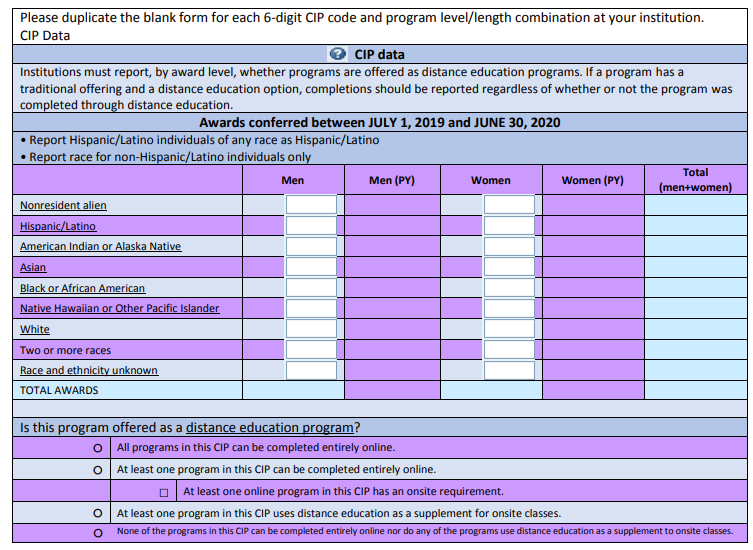
Response – Completions, Distance Education (Comment #s 31 and 32)
Dear Lor Miller,
In response to your recommendation to clarify the distance education questions in the Completions component, NCES will add “in this award level” to each of the response options. NCES will also change “supplement” to “non-mandatory” in the response options. The new version of the distance education question in the 30-day Federal Register Notice includes this terminology; changes can be seen in the document ‘IPEDS 2019-20 through 2021-22 C Completions’. We believe that the change in wording should result in a better understanding of the survey question and provide improved accuracy and quality of the data being reported.
Thank you for taking the time to provide comment.
Sincerely Yours,
Samuel F. Barbett
Acting Postsecondary Branch Chief
Administrative Data Division
Comment on the IPEDS data collection – Finance, Health Ratios (Comment # 33)
Document: ED-2019-ICCD-0028-0033
Name: Anonymous
Date posted: May 8, 2019
The proposed change is to add a new screen to collect numerator and denominator for calculating financial health ratios (applies to degree-granting institutions). This proposed change should comply with the Higher Learning Commission which excludes GASB 68 and GASB 75.
Response – Finance, Health Ratios (Comment #33)
Dear Anonymous,
The changes proposed to the Finance survey component are based on feedback from IPEDS Technical Review Panel #57, IPEDS Financial Metrics, held in December 2018. NCES uses feedback from higher education experts, including institution level data reporters, researchers, state governments, and higher education associations. NCES also regularly works with higher education experts to make changes based on changes to the Governmental Accounting Standards Board (GASB) accounting standards.
Through IPEDS, NCES collects and makes publicly available information related to the financing and management of postsecondary education to help meet data collection and reporting requirements outlined in federal statute; these requirements are often different from the requirements of regional accreditors (such as the Higher Learning Commission) and other entities.
NCES provides clear instructions and definitions to explain the data that are reported to NCES. We understand that institutions report to several entities in addition to NCES and that there may be questions on data. These instructions and definitions should be used when there are questions about the reported data.
Thank you for taking the time to provide comment.
Sincerely Yours,
Samuel F. Barbett
Acting Postsecondary Branch Chief
Administrative Data Division
Comment on the IPEDS data collection – Certificates, Distance Education, 12 Month Enrollment (Comment # 36)
Document: ED-2019-ICCD-0028-0036
Name: Mamie Voight
Date posted: May 17, 2019
In the attached letter, 34 signed members of the Postsecondary Data Collaborative submit our comment for review. PostsecData is a nonpartisan coalition of organizations representing students, higher education institutions, states, employers, and privacy and security experts committed to using high-quality postsecondary data to improve transparency, increase student success, and reduce educational inequity.
If you have any questions about these comments, please contact Mamie Voight, vice president of policy research at the Institute for Higher Education Policy (mvoight@ihep.org or 202-587-4967).
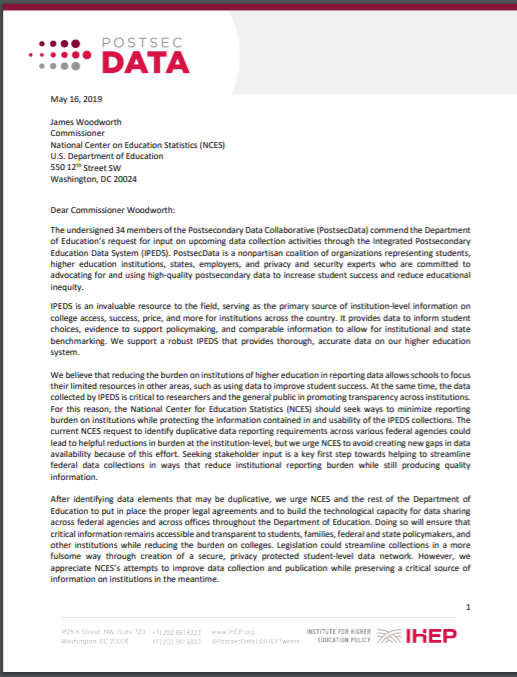
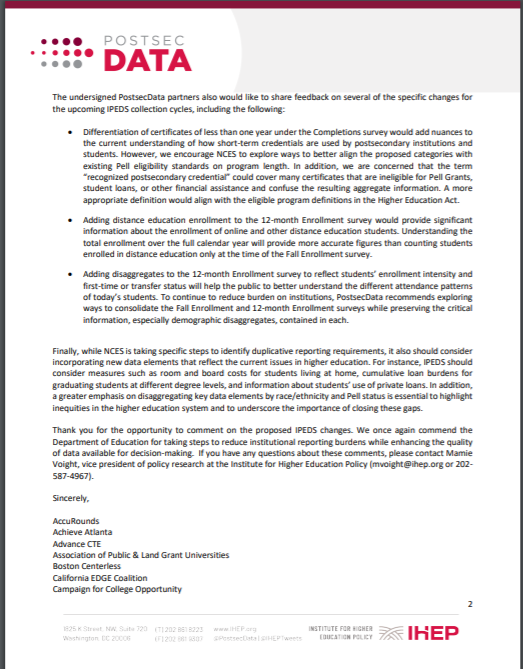

Response – Certificates, Distance Education, 12 Month Enrollment (Comment # 36)
Dear Mamie Voight,
NCES appreciates your comments related to balancing the need to reduce burden with the need for data to ensure transparency, and continues to work to address these concerns. As you noted, we are working to identify any ways we can decrease burden but do not want to create gaps in data, and any changes based on what we learn from this process would be undertaken with care not to create any gaps.
The changes to the certificates of less than one year were based on feedback from Technical Review Panel #52, Subbaccalaureate Certificates, held in March of 2017, as well as a paper commissioned by the National Postsecondary Education Cooperative (NPEC; Miller, A., Erwin, M., Richardson, S., Arntz, M. Collecting and disseminating data on certificate awards (NPEC 2016). U.S. Department of Education. Washington, DC: National Postsecondary Education Cooperative. Retrieved from https://nces.ed.gov/ipeds/resource/download/NPECCertificateAwardsData.pdf ). The TRP recommended revising the term “formal award”, and NCES worked with the NPEC to refine this term. The term “recognized credential” is used by the Office of Federal Student Aid (FSA), and the term “recognized postsecondary credential” is used by the Workforce Innovation and Opportunity Act (WIOA). In order to be clear to institutions, and to better align with FSA and the WIOA, NCES chose to use the term “recognized postsecondary credential”. It is important to note that the data collected in the Completions component does currently include non-Title IV eligible certificates, and the TRP recommended keeping non-Title IV certificates because restricting certificates to Title IV eligible programs would greatly reduce the total number of certificates reported each year and underestimate the instructional activity provided by these institutions.
Thank you for your support of the changes to distance education and to the disaggregation of categories in the 12 Month Enrollment component, as well as your suggestions for new data elements. NCES will continue, through its research and development process, to consider changes that are key to maintaining the relevance and utility of IPEDS data.
Thank you for taking the time to provide comment.
Sincerely Yours,
Samuel F. Barbett
Acting Postsecondary Branch Chief
Administrative Data Division
Comment on the IPEDS data collection – Completions and 12 Month Enrollment (Comment #s 38 and 53)
Document: ED-2019-ICCD-0028-0038
Name: Suzanne Simpson
Date posted: May 20, 2019
See attached file for comments regarding ED-2019-ICCD-0028.

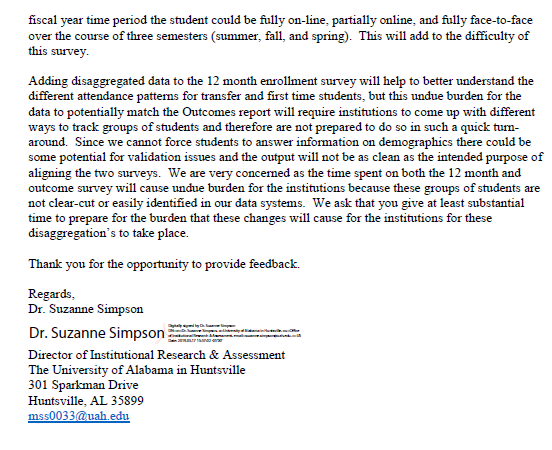
Document: ED-2019-ICCD-0028-0053
Name: Jennifer Moore
Date posted: May 21, 2019

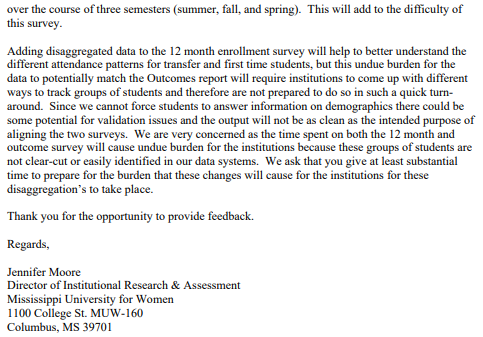
Response – Completions and 12 Month Enrollment (Comment #s 38 and 53)
Dear Suzanne Simpson and Jennifer Moore,
The change to the certificates of less than one year were based on feedback from Technical Review Panel #52, Subbaccalaureate Certificates, held in March of 2017, as well as a paper commissioned by the National Postsecondary Education Cooperative (NPEC; Miller, A., Erwin, M., Richardson, S., Arntz, M. Collecting and disseminating data on certificate awards (NPEC 2016). U.S. Department of Education. Washington, DC: National Postsecondary Education Cooperative. Retrieved from https://nces.ed.gov/ipeds/resource/download/NPECCertificateAwardsData.pdf ). The TRP recommended revising the term “formal award”, and NCES worked with the NPEC to refine this term. The term “recognized credential” is used by the Office of Federal Student Aid (FSA), and the term “recognized postsecondary credential” is used by the Workforce Innovation and Opportunity Act (WIOA). In order to be clear to institutions, and to better align with FSA and the WIOA, NCES chose to use the term “recognized postsecondary credential”. It is important to note that the data collected in the Completions component does currently include non-Title IV eligible certificates, and the TRP recommended keeping non-Title IV certificates because restricting certificates to Title IV eligible programs would greatly reduce the total number of certificates reported each year and underestimate the instructional activity provided by these institutions.
In response to your recommendation to clarify the distance education questions in the Completions component, NCES will add “in this award level” to each of the response options. NCES will also change “supplement” to “non-mandatory” in the response options. The new version of the distance education question in the 30-day Federal Register Notice includes this terminology; changes can be seen in the document ‘IPEDS 2019-20 through 2021-22 C Completions’. We believe that the change in wording should result in a better understanding of the survey question and provide improved accuracy and quality of the data being reported.
The proposed distance education questions on enrollment are currently collected in the Fall Enrollment survey component, and NCES understands that students may change their enrollment status. Institutions are instructed to report students that were considered distance education students at any point within the 12-month enrollment period.
There are several reasons for the proposed change to 12-month Enrollment (E12) survey component, including demand and interest from the data users/researcher community, requests from Technical Review Panels (TRPs), and enhancement of data quality.
NCES collects institutional enrollment data twice per year. The Fall Enrollment (EF) survey component is a snapshot of enrollment counts during the fall term, with data disaggregated by race/ethnicity, gender, student level (i.e., undergraduate and graduate level), age, state of residence, attendance status, degree-seeking status, and major field of study. The 12-month Enrollment (E12) component collects a cumulative, unduplicated headcount of students enrolled at any point over the course of an entire calendar year, but is currently disaggregated only by student level, gender, and race/ethnicity.
Data users and researchers have consistently voiced their interest in and demand for EF data disaggregations to be collected in the E12 survey component. Panelists attending TRP #54, Exploring Topical Issues in Higher Education (held in October 2017) suggested that including the disaggregations collected in the EF survey component within the E12 survey component will streamline existing reporting and minimize burden while increasing utility of the data.
Institutions have reported data disaggregated by these same categories for the EF since the 2006-07 data collection, and by doing so have already established these groups in their database programming or collection system. NCES is asking for institutions to extend the count to a 12-month period, which presents better enrollment data for program institutions with continuous enrollment. As EF data only captures one point of an institution’s enrollment, E12 data allows institutions to be transparent about their enrollment activities by having unduplicated, 12-month period enrollment data.
Finally, adding EF data elements to E12 allows for a better integration of the Outcome Measures (OM) and E12 survey components, resulting in better alignment of IPEDS data, enhancement of data checks, and improvement of data quality. Like the alignment of EF and the Graduation Rates (GR) survey components, where the cohort data for the graduation rate information reported in GR are collected in the EF survey component, the cohort data for the OM survey component will be collected in the E12 survey component.
We understand that institutions report to several entities in addition to NCES and that there may be questions on data. NCES provides clear instructions and definitions to explain the data that are reported to NCES. These instructions and definitions should be used when there are questions about the reported data, particularly when compared with data from other entities (e.g., state level education departments).
Thank you for taking the time to provide comment.
Sincerely Yours,
Samuel F. Barbett
Acting Postsecondary Branch Chief
Administrative Data Division
Comments on the IPEDS data collection – Recognized Postsecondary Credential (Comment #s 40, 37, 43, 39, 51 and 57)
Document: ED-2019-ICCD-0028-0040
Name: Julie Pollard
Date posted: May 20, 2019
I wholeheartedly agree with the attached Comments from the National Coordinating Center on Transition and Postsecondary Programs for Students with Intellectual Disabilities on the Proposed Use of the WIOA definition of Recognized Postsecondary Credential in the IPEDs Data Collection Efforts.
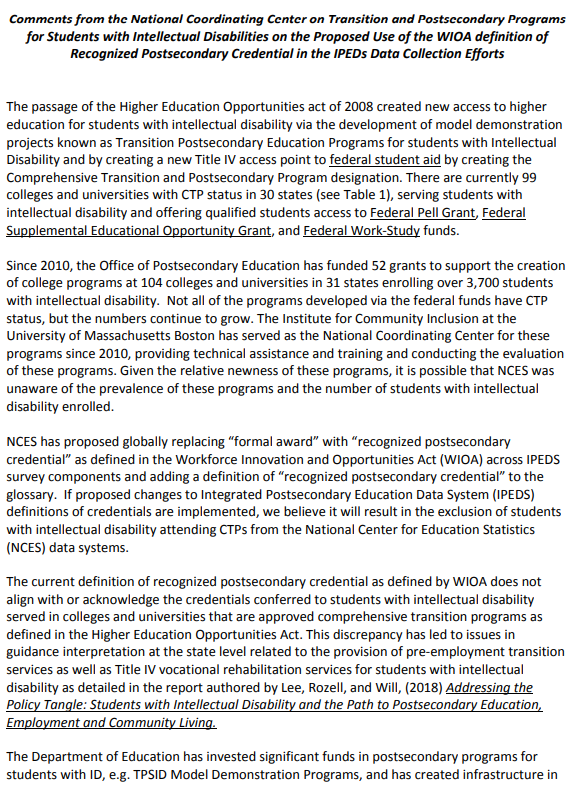
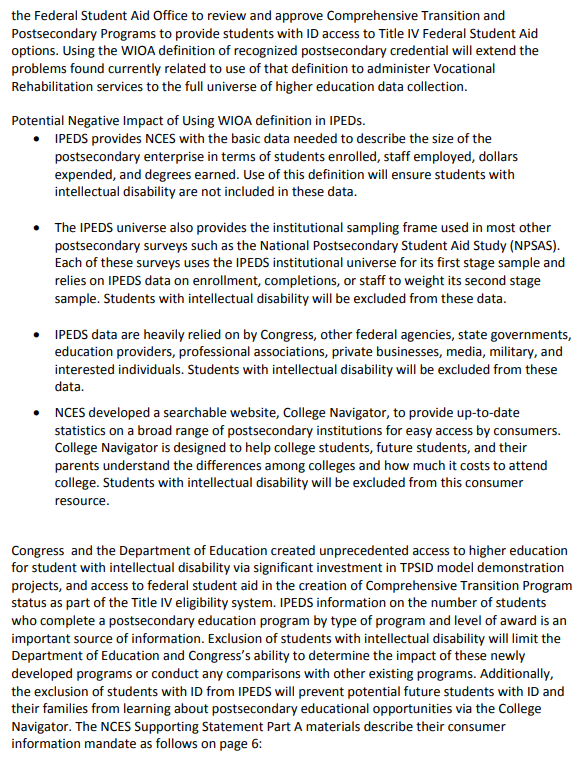
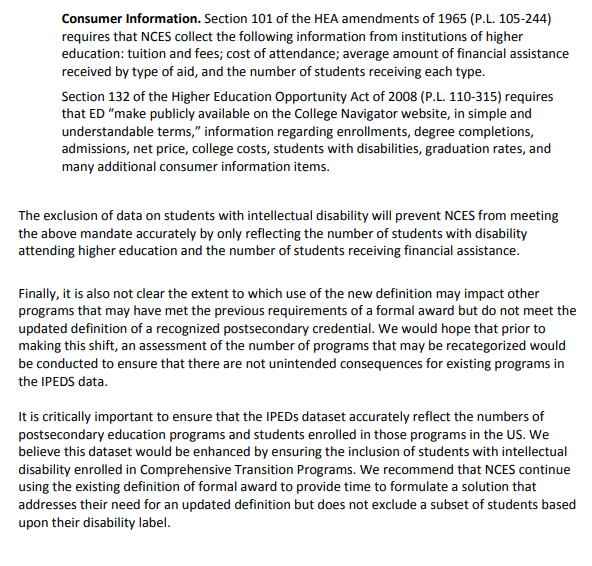
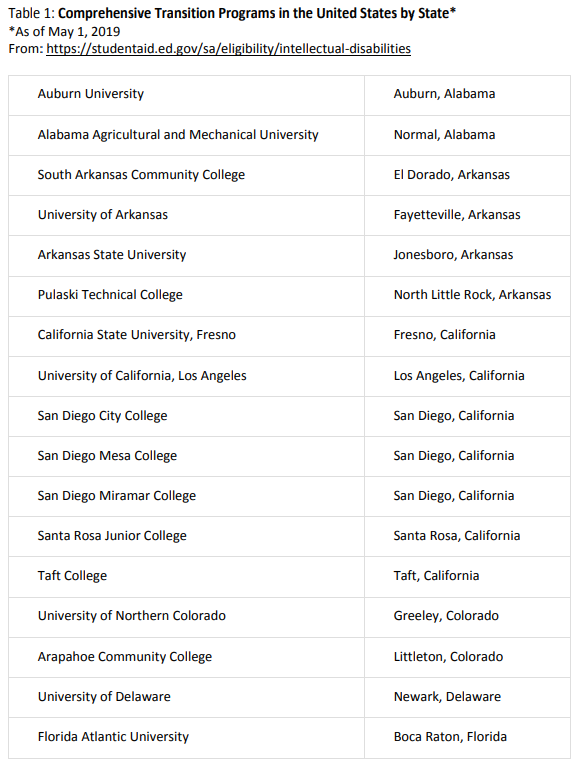

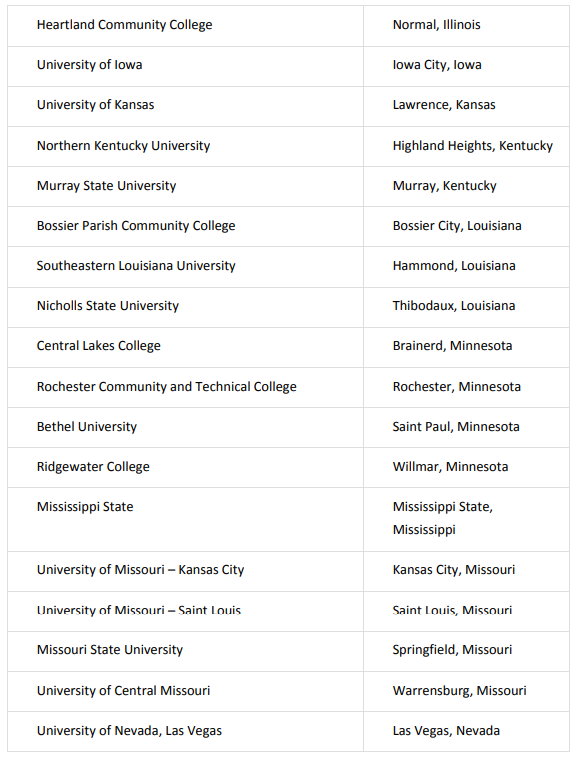
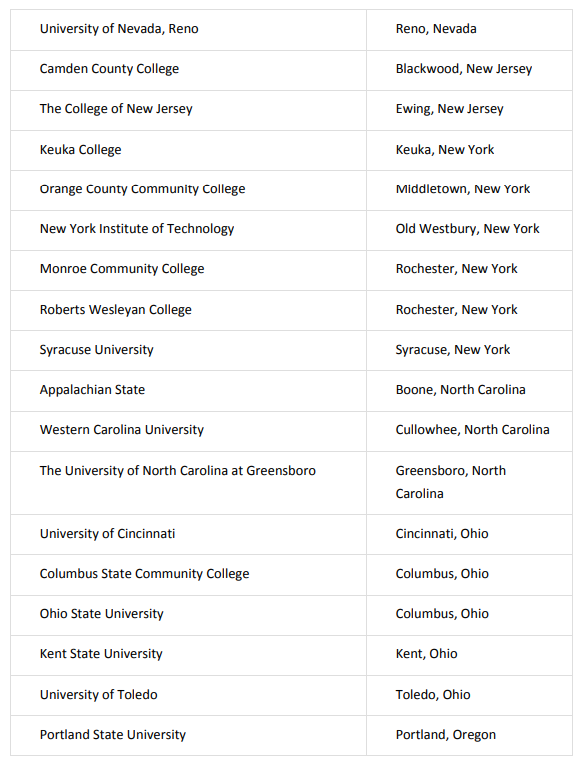
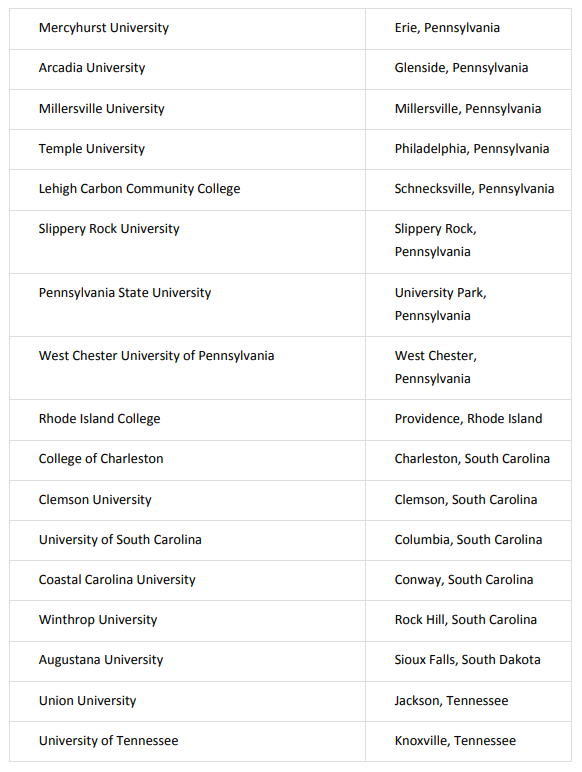
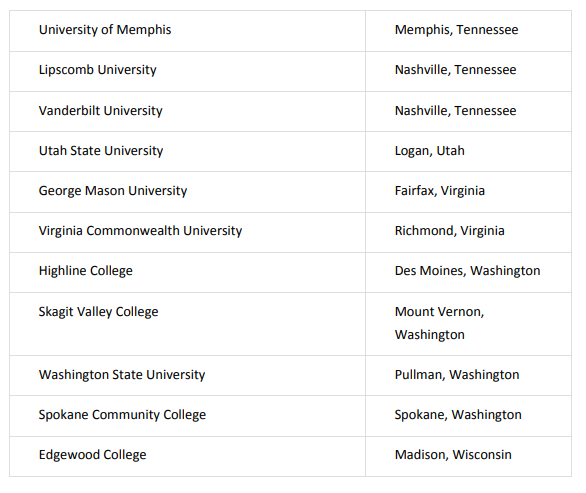
Document: ED-2019-ICCD-0028-0037
Name: Stephanie Smith Lee
Date posted: May 20, 2019
This
comment regarding proposed changes to IPEDs data collection is
submitted on behalf of the National Down Syndrome Congress (NDSC),
the oldest national organization serving individuals with Down
syndrome, their families, and the professionals who work with them.
We represent the estimated 350,000 individuals living with Down
syndrome in the United States and others worldwide and are the
leading national organization providing resource support,
information, and advocacy for those touched by or seeking to learn
about Down syndrome, from the moment of prenatal diagnosis through
adulthood.
NDSC
has long been a leading advocate for inclusive postsecondary
education opportunities for students with intellectual disabilities.
We are a part of the Inclusive Higher Education Committee that
successfully advocated for amendments to the Higher Education
Opportunity Act of 2008 that allowed certain financial aid for
students with ID enrolled in US Department of Education-approved
Comprehensive Transition and Postsecondary Programs (CTPs), and
authorized funding for model Transition Postsecondary Education
Programs for students with Intellectual Disability (TPSIDs). The
academic, career, and independent living opportunities for
postsecondary students with ID have expanded dramatically under these
new provisions.
We
support the comments submitted by the National Coordinating Center on
Transition and Postsecondary Programs for Students with Intellectual
Disabilities (NCC) objecting to changing the existing use of "formal
award" in IPEDs data collection to recognized postsecondary
credential as defined in the Workforce Innovation and Opportunities
Act (WIOA) across IPEDS survey components and adding the WIOA
definition of recognized postsecondary credential to the glossary.
This action would eliminate much-needed data collection regarding
CTPs that is critically important to students with intellectual
disability and their families. We agree with the NCC that additional
time is needed to formulate a solution that addresses the National
Center for Education Statistics interest in an updated definition but
does not exclude a subset of students based upon their disability
label. Thank you for this opportunity to comment.

Document: ED-2019-ICCD-0028-0043
Name: Meg Grigal
Date posted: May 20, 2019
In the attached letter we provide comments from the National Coordinating Center for Transition and Postsecondary Programs for Students with Intellectual Disabilities on the proposed use of the WIOA definition of recognized postsecondary credential in the IPEDs data collection efforts as it could unintentionally exclude data on college students with intellectual disability. If you have any questions about these comments please contact Dr. Meg Grigal, Senior Research Fellow, at the Institute for Community Inclusion at University of Massachusetts Boston (meg.grigal@umb.edu).
Thank you for the opportunity to comment on these proposed changes.

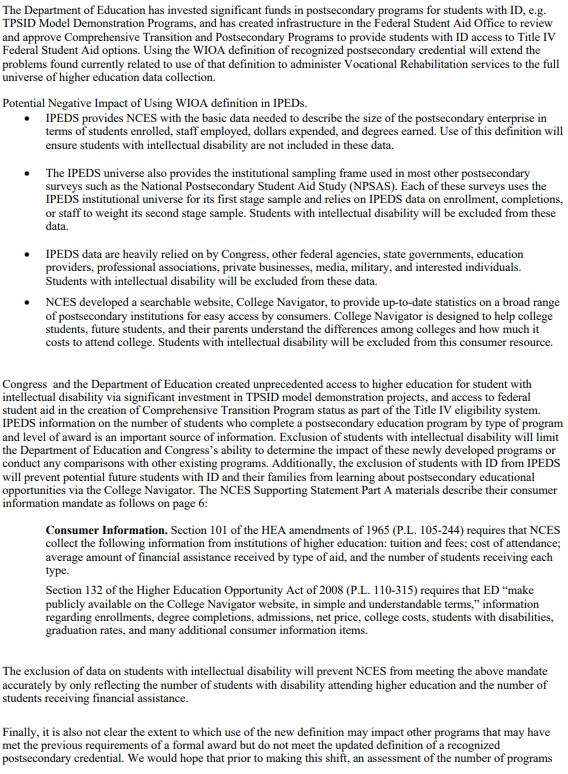
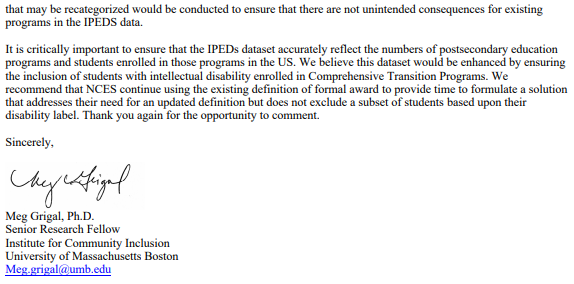
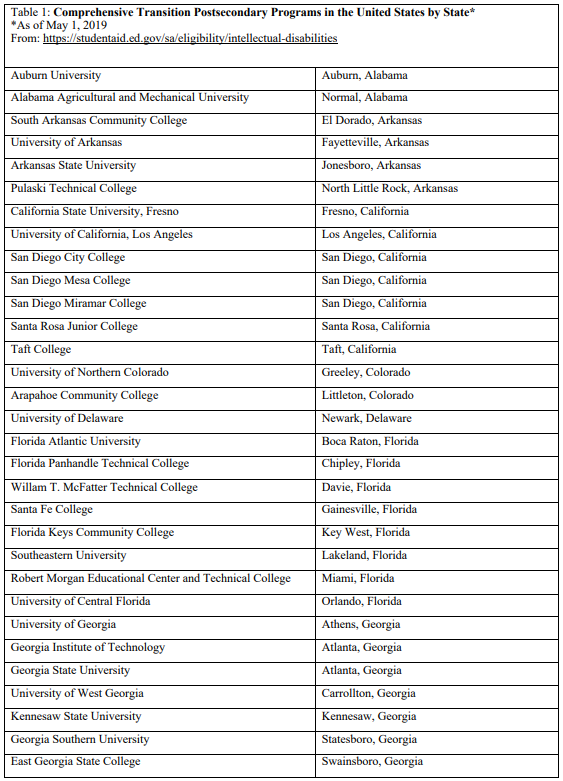
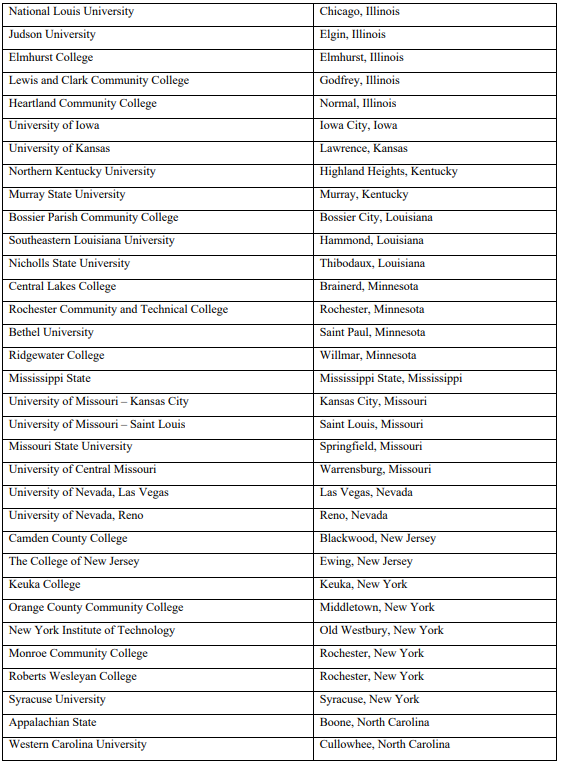
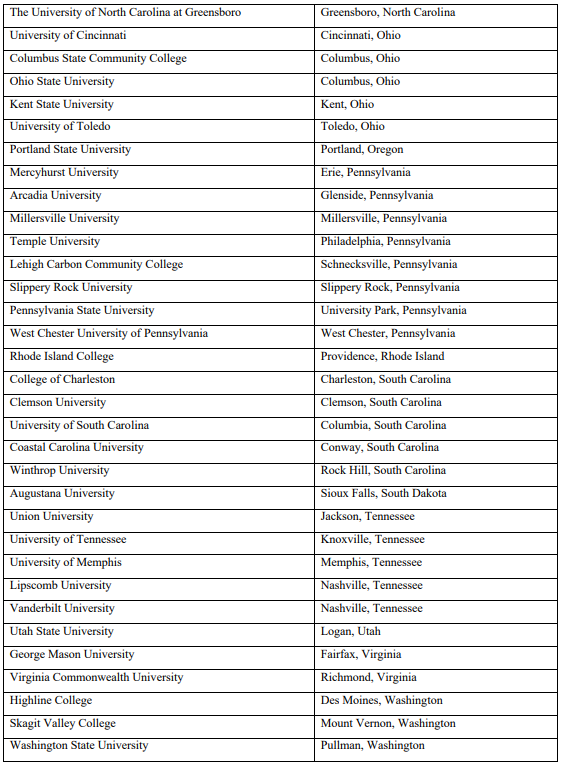


Document: ED-2019-ICCD-0028-0039
Name: Denise Rozell
Date posted: May 20, 2019
This comment regarding proposed changes to the IPEDs data collection is submitted on behalf of the Association of University Centers on Disabilities (AUCD), AUCD works to advance policies, practices, and research that improve the health, education, and social and economic well-being of children and adults with disabilities, their families and their communities through a national network of university centers in every state and territory.
AUCD envisions a future in which all people, including those living with developmental and other disabilities, are fully included, participating members of their communities. We see equitable access to supports and services that reflect the preferences and values of diverse communities and that lead to self-determination, independence, productivity, and a healthy and satisfying quality of life.
As such, AUCD is a leading advocate for postsecondary education opportunities for all students, including students with intellectual disabilities (ID). AUCD is a member of the Inclusive Higher Education Committee that successfully advocated for amendments to the Higher Education Opportunity Act of 2008. It was that legislation that allowed certain financial aid for students with ID enrolled in US Department of Education-approved Comprehensive Transition and Postsecondary Programs (CTPs), and authorized funding for model Transition Postsecondary Education Programs for students with Intellectual Disability (TPSIDs). The academic, career, and independent living opportunities for postsecondary students with ID have expanded dramatically under these new provisions.
We support the comments submitted by the National Coordinating Center on Transition and Postsecondary Programs for Students with Intellectual Disabilities (NCC) objecting to changing the existing use of "formal award" in IPEDs data collection to recognized postsecondary credential as defined in the Workforce Innovation and Opportunities Act (WIOA) across IPEDS survey components and adding the WIOA definition of recognized postsecondary credential to the glossary. This action would eliminate much-needed data collection regarding CTPs and students with ID that is critically important to ensure that the IPEDs dataset accurately reflect the numbers of all postsecondary education programs and all students enrolled in those programs in the US, including students with intellectual disabilities. We agree with the NCC that additional time is needed to formulate a solution that addresses the National Center for Education Statistics interest in an updated definition but does not exclude a subset of students based upon their disability label. Thank you for this opportunity to comment.

Document: ED-2019-ICCD-0028-0051
Name: Margo Izzo
Date posted: May 21, 2019
Comments from Ohio's Statewide Consortium:
Since 2010, eight colleges and universities across Ohio have established "Comprehensive Transition and Postsecondary Programs across Ohio and five of these programs are recognized by the US Department of Education with CTP status. Once a program is established as a CTP, students with intellectual disabilities are eligible for Pell Grants. Across Ohio, over 200 students with ID are receiving postsecondary services that result in increased employment and quality of living outcomes. Of the 200 students with ID enrolled in the eight programs, less than 10% are pursuing an industry recognized credential. Yet, employment outcomes of Ohio's CTP graduates exceed 75%, more than double the NLTS2 employment data (Newman et al., 2011) and triple the 2016 American Census Survey data. Clearly CTP programs assist students with intellectual disabilities gain increased employment outcomes. But these students do not necessarily gain an industry recognized credential.
We do not agree with NCES' proposal to replace "formal award" with "recognized postsecondary credential". Too many of our students who complete CTP programs would not be included in the dataset. Further, we agree with the statement provided by the National Coordinating Center on Transition and Postsecondary Programs for Students with Intellectual Disabilities. It is critically important to ensure that the IPES dataset accurately reflect the numbers of postsecondary programs and students enrolled in those programs in the US.

Document: ED-2019-ICCD-0028-0057
Name: Tammy Day
Date posted: May 21, 2019
The comments previously submitted by the National Coordinating on Transition and Postsecondary Programs for Students with Intellectual Disability are fully supported by the faculty advisers and staff with the Next Steps at Vanderbilt inclusive higher education program. It is critical that students enrolled through Next Steps continue to be included in IPEDS data collection. We share the concern that the proposed language of recognized postsecondary credential will result in the exclusion of this group of students. These students and their families are taking significant steps for higher education programming that includes all of the typical college resources of time and finances. Without being included in these data sets, their ability to be fully-included on our university campus initiatives will most likely be negatively impacted. We are also leaders in our states TN Inclusive Higher Education Alliance that works closely with state legislators that have allocated state tuition assistance dollars for this population of students. This data needs to continue being collected by IPEDS so that our state legislators can more easily develop ways to report data on our states six programs and their impact on the students with intellectual disability.
Response – Recognized Postsecondary Credential (Comment #s 40, 37, 43, 39, 51, 57)
Dear Julie Pollard, Stephanie Smith Lee, Meg Grigal, Denise Rozell, Margo Izzo, and Tammy Day,
NCES appreciates your concerns related to replacing the term ‘formal award’ with the term ‘recognized postsecondary credential’. This change is being made for several reasons, including feedback from institutions that the term ‘award’ is confusing when reporting. In other areas of the Department of Education, as well as in the Higher Education Act (2008, as amended), the term ‘award’ is used exclusively in relation to financial aid in the Higher Education Act of 2008. The Office of Federal Student Aid (FSA), an office of the Department of Education (ED), defines the term award as: financial aid that is offered to students. This issue was also discussed during the Technical Review Panel #52, Subbaccalaureate certificates.
Based on feedback from institutions and from TRP 52, NCES worked with the National Postsecondary Education Cooperative (NPEC) to determine a more appropriate and clear term to collect data in IPEDS. In addition, NCES sought to align the IPEDS terminology with terms used in other ED offices and in law. The term ‘recognized credential’ is used in the Information for Financial Aid Professionals (IFAP) institutional eligibility document and ‘recognized educational credential’ is used in FSA instructions, which is part of the language defining an eligible institution in 34 CFR 668.8. Finally, the term ‘credential’ is used in the Higher Education Act, as amended. Finally, NPEC agreed that it should be made clear that any recognized credentials need to be at the postsecondary level; based on all of this research and feedback from experts, NCES decided to use the term ‘recognized postsecondary credential’ as a more accurate term that is aligned with other federal agencies and law.
Comprehensive Transition Programs (CTP) are eligible for federal student aid (Title IV), and therefore need to be reported to IPEDS. The term ‘recognized postsecondary credential’ covers all programs that are covered by Title IV federal funding, and also requires the reporting of programs that are not covered by Title IV federal funding. The term ‘recognized postsecondary credential’ does not allow institutions to forego reporting Title IV programs, including CTP. NCES agrees that it is critically important that data reported to IPEDS accurately reflect the number of students within all Title IV programs, therefore, NCES has made a slight change to the definition by removing the reference to the Workforce Innovation and Opportunity Act (WIOA) (so that institutions do not report to IPEDS based on WIOA performance accountability provisions), and developed an FAQ to address your concerns. These changes are included in Appendix A. In addition, NCES requests feedback on the definition and the FAQ in ‘Appendix D - IPEDS 2019-20 through 2021-22 Directed Questions’. NCES encourages feedback that can help NCES to ensure that all students with disabilities participating in CTPs are included in the IPEDS and other NCES surveys, while also helping NCES to use a more appropriate and measurable definition.
Thank you for taking the time to provide comment.
Sincerely Yours,
Samuel F. Barbett
Acting Postsecondary Branch Chief
Administrative Data Division
Comment on the IPEDS data collection – Finance (Comment # 41)
Document number: ED-2019-ICCD-0028-0041
Name: Laura Benson Marotta
Date posted: May 20, 2019
This
comment concerns Detailed Proposed Changes to Forms by IPEDS Survey
Component OMB No. 1850-0582 v.24.
The
dual goals of the IPEDS Finance changes in maintaining validity and
providing information important to stakeholders appears to be at odds
with financial health indicators for public institutions as proposed
for the 2020-21 collection on Table A6. Proposed Changes to the
Finance Forms. From an Institutional Research perspective, the
concept of validity at its core means to measure what we are trying
to measure. While capturing Other Than Pension Post-Employment
Benefits as mandated by GASB Statements 74/75 may be a laudable
effort in understanding public finance, it heavily detracts from
understanding which liabilities public campuses need to cover if
Other Postemployment Benefits (OPEB) are paid from a state pension
fund or its general fund. A public campus is not likely to ever have
assets to cover the OPEB liabilities when it is not our bill to pay.
This grain of reporting issue is something that Institutional
Research offices need to reiterate to multiple constituencies,
including our accrediting body, when IPEDS-derived financial ratios
significantly fail to measure what appears to be their goal:
describing the financial health of the campus. The estimated burden
to campuses under this proposal is far from minimal because there is
no mention of removing OPEB expenses before calculating financial
ratios if OPEB liabilities are not included in the General Purpose
Financial Statements. Public institutions will put in the position of
needing to lock mandated reports with adherence to GASB 74/75 and
then spend staff time explaining why the federally reported finance
ratios do not reflect the campus financial situation.
Response – Recognized Postsecondary Credential (Comment # 41)
Dear Laura Benson Marotta,
IPEDS Finance survey forms include specific instructions to exclude net pension or net other postemployment benefits (OPEB) liabilities/assets from Financial Health Ratios part that is intended to collect the numerator and denominator used to calculate financial health ratios that compose the Composite Financial Index (CFI). Therefore, OPEB liabilities are not included in calculating financial ratios.
Thank you for taking the time to provide comment.
Sincerely Yours,
Sam Barbett
Acting Postsecondary Branch Chief
Administrative Data Division
Comment on the IPEDS data collection – Students with Disabilities (Comment # 56)
Document: ED-2019-ICCD-0028-0056
Name: Meghan Whittaker
Date posted: May 21, 2019
On behalf of the National Center for Learning Disabilities (NCLD), I am writing in response to the U.S. Department of Education's (ED) invitation to submit comments on Docket No. ED-2019-ICCD-0028. Our comments are intended to express our strong support for the IPEDS data collection and provide input on the type of information that should be collected in the future. Please find NCLD's full comments attached here.
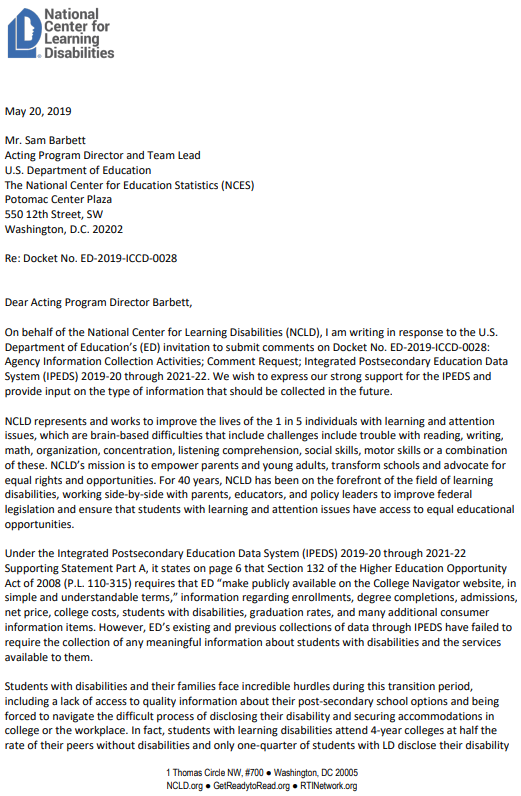
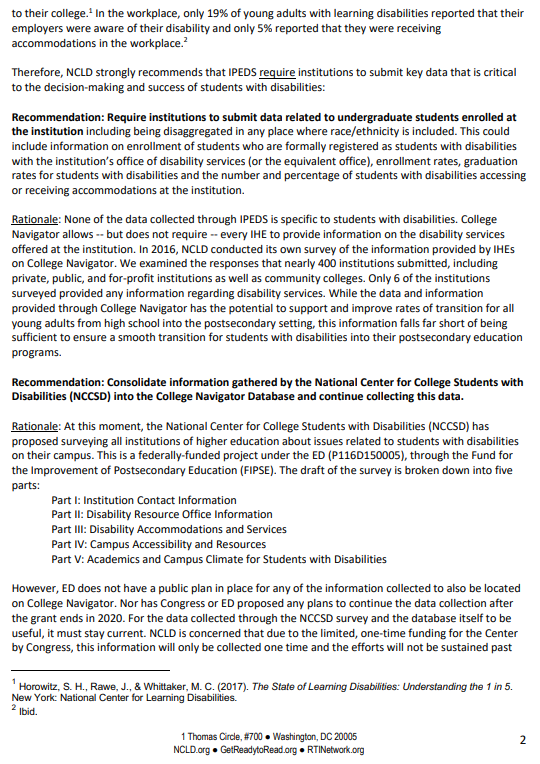
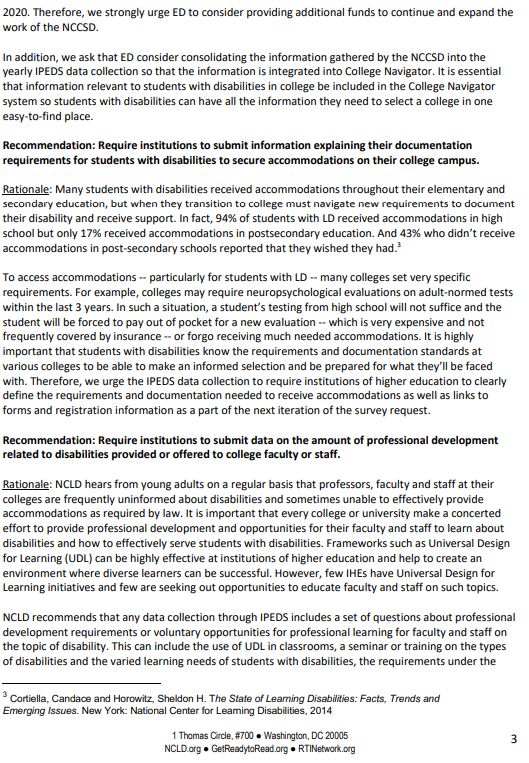
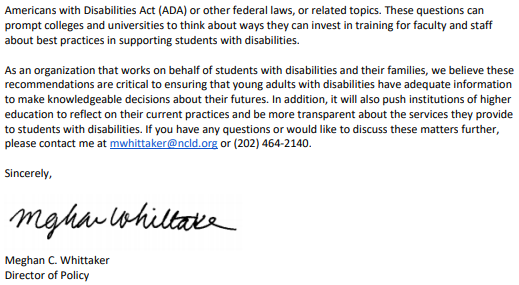
Response – Students with Disabilities (Comment # 56)
Dear Meghan Whittaker,
Thank you for your recommendations to improve data collection for students with disabilities. Currently, NCES makes available on College Navigator information about the percentage of undergraduate students enrolled who are formally registered with office of disability services, as well as a link to the ‘Disability Services’ website at institutions. These data elements were added to the IPEDS data collection as a response to the requirements of the Higher Education Act, as amended, and were based on expert recommendations and the ability of institutions to report accurate information to the IPEDS without placing undue burden on institutions.
There are a number of concerns that have been brought to the attention of NCES with collecting disability data at the detail level in your recommendation. One concern is related to the accuracy of any data that would be reported at that level. Institutions have told NCES that they cannot report information at that level of detail, so any data reported would be inaccurate and potentially misleading, as well as extremely burdensome to institutions. In addition, since a majority of institutions have a small percentage of students registered with their office of disability services, collecting data at that level would lead to extremely small cell sizes and risk the ability to identify an individual student. In order to maintain quality and privacy with IPEDS data, NCES does not plan to add data at that detail level at this time.
NCES consulted with the National Center for College Students with Disabilities as they developed their survey instrument. NCES does not have the capacity within IPEDS to collect the level of detail collected in that survey, in addition, as mentioned previously, the data that will be reported by institutions would be a high burden placed on institutions because they do not all have the capacity to report at that detail level. This is different for IPEDS than for NCCSD because IPEDS is a compliance survey and institutions face steep fines for not submitting data or for submitting poor quality data. In addition, any data that would be collected would likely be of poor quality and would introduce risks to student privacy.
Finally, NCES does not collect information about professional development in the IPEDS and has no plans at this time to introduce that type of collection.
Thank you for taking the time to provide comment.
Sincerely Yours,
Samuel F. Barbett
Acting Postsecondary Branch Chief
Administrative Data Division
Comment on the IPEDS data collection – Outcome Measures (Comment # 45)
Document: ED-2019-ICCD-0028-0045
Name: Anonymous
Date posted: May 20, 2019
Thank you for the opportunity to comment. Congratulations on the introduction of the Outcome Measures survey, a huge improvement from the statuary graduation rate that only captures the outcomes of first-time, full-time students. While the survey has become critical to understanding how many students actually complete a college credential, right now, it fails to include institutions that only offer certificates as their highest credential. This, in turn, leaves out thousands of institutions and millions of student outcomes from the OM survey, making the information impossible to compare and use for students and families that are focused on making a college decision. I encourage you to have certificate-granting institutions submit information through the OM Survey, as well, since the first-time, full-time graduation rate is unrepresentative of today's students.
Response – Outcome Measures (Comment # 45)
Dear Anonymous,
NCES appreciates your comment that proposes that the Outcome Measures (OM) survey component also collect from non-degree-granting institutions, which would follow the purpose of OM to show a more complete picture of the higher education enrollment and completions of all the students in the United States. Three years ago, NCES initially investigated the proposal of requiring non-degree-granting institutions to report to the Outcome Measures survey component. However, TRP #50 recommended that the reporting burden may be too great for non-degree-granting institutions; based on that recommendation, NCES decided to wait until the OM collection stabilizes before returning to this line of inquiry on the reporting possibility and burden for non-degree-granting institutions. Because OM is the newest survey in the IPEDS collection and only has two annual collections that implemented the new full-year reporting and Pell subcohorts changes, NCES is still observing the quality and stabilization of the OM data that are reported by degree-granting institutions. In the meantime, NCES will continue to investigate the potential to implement OM for non-degree granting institutions in future collections.
Thank you for taking the time to provide comment.
Sincerely Yours,
Samuel F. Barbett
Acting Postsecondary Branch Chief
Administrative Data Division
Comment on the IPEDS data collection – Outcome Measures (Comment # 52)
Document: ED-2019-ICCD-0028-0052
Name: Bob Goga
Date posted: May 21, 2019
Suggested Revisions Statement of Purpose:
To ensure consistency in reporting to the NCES, there is need for clarification in the instructions/definitions that accompany the Graduation Rates Survey, the Graduation Rates 200 Survey, the Outcomes Measures Survey, and the Fall Enrolment Survey. The NCES acknowledges each campus of a multi-campus university as an institution, and assigns to each an IPEDS Unit ID. That acknowledgement has a special meaning for multi-campus universities in that each universities campuses is an IPEDS institution. And as such, it needs to be reiterated in the survey instructions/definitions that data are to be reported via the aforementioned surveys by IPEDS institution=campus. To that point, what follows, then, is the need for clarification on: 1) who is a program completer and 2) who is a transfer-in and who is a transfer-out.
1. Who is a Program Completer? (GR, GR-200, Outcomes Measures):
The instructions for, e.g., the Graduation Rates Survey includes a Special Note which presently reads, as follows: Do not count as completers students who receive their degree from another institution. This Special Note should be expanded to read, as follows: Do not count as completers students who receive their degree from another institution. NCES recognizes a branch/regional campus of a multi-campus university as an institution, and assigns to it a unique IPEDS Unit ID. As such, a multi-campus universitys student can be reported as graduated only if he or she completes at the campus -- of that multi-campus university -- at which he or she was initially enrolled.
2. Who is a Transfer-In and who is a Transfer-Out? (GR, OM, Fall Enrollment):
The instructions for, e.g., the Outcomes Measures Survey defines a transfer-in as a student entering the reporting institution for the first-time but known to have previously attended; and defines as a transfer-out as a student that leaves the reporting institution and enrolls at another institution. Both of these definitions need to convey the following: NCES recognizes a branch/regional campus of a multi-campus university as an institution, and assigns to it a unique IPEDS Unit ID. As such, a multi-campus universitys student is to be reported as transferring-in were that student to have transferred-in from another of the universitys campuses, just as students who transfer-in from another college or university. Likewise, a multi-campus universitys student is to be reported as transferring-out when transferring to another of the multi-campus universitys campuses, just as would a student who transfers-out to another college or university.
I appreciate having this opportunity to suggest to you improvements in the data collection.
Response – Outcome Measures (Comment # 52)
Dear Bob Goga,
You are correct that only institutions with a unique IPEDS Unit ID can report the student as a completer if the institutions conferred the award/degree. Institutions that transferred-out a student to another institution within the coordinated system can only report that student as a transfer-out and cannot report that student as a completer. Institutions that report transfer-outs as completers would be double counting the same student from a national perspective. Per your comment, NCES has developed clarifications for the IPEDS glossary terms “transfer-in” and “transfer-out” students as well as FAQs for the Outcome Measures, Graduation Rates, and 200% Graduation Rates survey components, which can be reviewed and commented through the 30-day public comment period.
Thank you for taking the time to provide comment.
Sincerely Yours,
Samuel F. Barbett
Acting Postsecondary Branch Chief
Administrative Data Division
Comment on the IPEDS data collection – HR SOC, Academic Libraries, and Finance (Comment # 48)
Document: ED-2019-ICCD-0028-0048
Name: Marissa Fox
Date posted: May 21, 2019
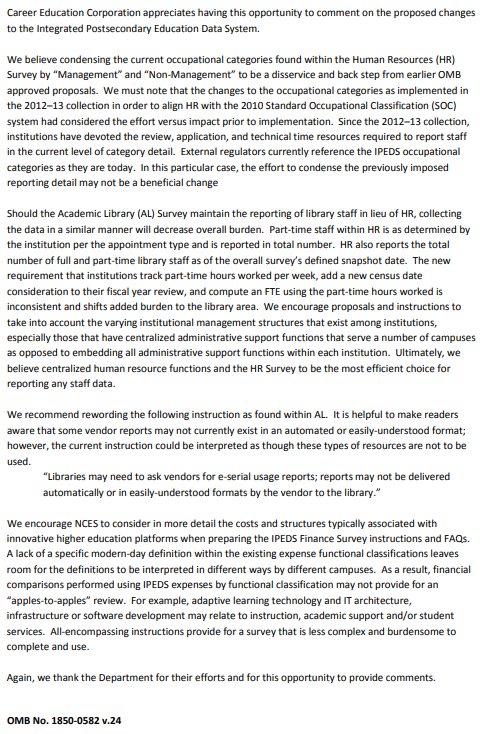
Response – HR SOC, Academic Libraries, and Finance (Comment # 48)
Dear Marissa Fox,
Thank you for your response on NCES’s attempt to reduce burden by removing the Standard Occupational Category (SOC) codes from the Human Resource (HR) component. After receiving similar feedback from other federal agencies and postsecondary institutions NCES determined that it is necessary to include SOC codes in the HR component. NCES provides these data to other federal agencies to meet required reporting requirements, which impede IPEDS ability to currently remove these reporting measures from the collection. IPEDS will continue to evaluate other options available to reduce reporting burden for the HR component and across all IPEDS surveys. However, the IPEDS HR survey will not currently incur any changes from that of the 2018-2019 collection.
In response to your comment on instructional changes for collecting digital/electronic usage on the Academic Libraries (AL) survey, NCES plans to work with the Association of College and Research Libraries (ACRL) and Association of Research Libraries (ARL) Joint Advisory Task Force on providing more guidance in the instructions and will consider your proposed changes when updating the instructions. Any changes made to these instructions will be provided in a future Office of Management and Budget IPEDS Change Memo and made prior to these new categories being collect in 2020-2021; NCES will post these changes to the changes page (https://surveys.nces.ed.gov/ipeds/ViewIPEDSChangesToTheCurrentYear.aspx) prior to the collection.
Your suggestion related to the Finance definitions is something that NCES intends to continue improving, but requires continued research and discussion with stakeholders on ways to capture the changing costs and structures of higher education platforms.
Thank you for taking the time to provide comment.
Sincerely yours,
Samuel F. Barbett
Acting Postsecondary Branch Chief
Administrative Data Division
Comment on the IPEDS data collection – Distance Education, E12, and Finance (Comment # 46)
Document: ED-2019-ICCD-0028-0046
Name: Stephanie Hall
Date posted: May 20, 2019
The attached letter, signed by 18 individuals and organizations, serves as our comment regarding proposed changes to IPEDS (Docket ED-2019-ICCD-0028).

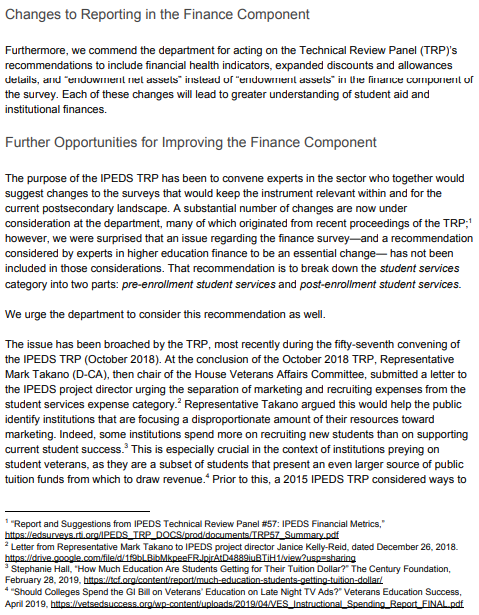
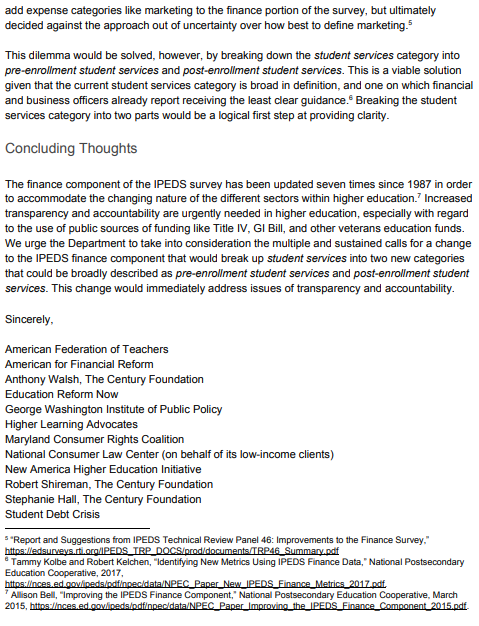

Response – Distance Education, E12, and Finance (Comment # 46)
Dear Stephanie Hall,
Thank you for your comment in support of the changes being proposed to distance education, 12-month enrollment, and Finance.
NCES appreciates your suggestions to reform the “student services” metric to better reflect student-centered spending and to report spending on marketing and recruitment separately. During some of our discussions with experts, this topic was brought up and the feedback we have received is that this will require further research and discussion with stakeholders to properly collect these data while ensuring the data collected are of high quality and the reporting of the data is not overly burdensome to institutions.
Thank you for taking the time to provide comment.
Sincerely yours,
Samuel F. Barbett
Acting Postsecondary Branch Chief
Administrative Data Division
Comment on the IPEDS data collection –Finance (Comment # 47)
Document: ED-2019-ICCD-0028-0047
Name: James Haynes
Date posted: May 21, 2019
I am submitting the attached comment on behalf of Veterans Education Success.
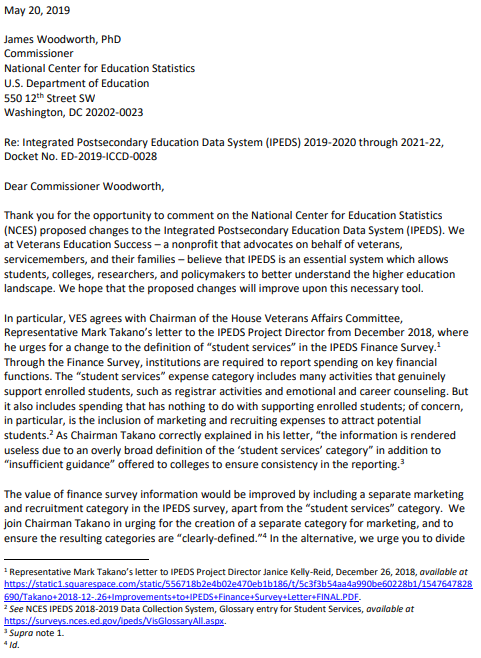

Response –Finance (Comment # 47)
Dear James Haynes,
NCES appreciates your suggestions to reform the “student services” metric to better reflect student-centered spending and to report spending on marketing and recruitment separately. During some of our discussions with experts, this topic was brought up and the feedback we have received is that this will require further research and discussion with stakeholders to properly collect these data while ensuring the data collected are of high quality and the reporting of the data is not overly burdensome to institutions.
Thank you for taking the time to provide comment.
Sincerely yours,
Samuel F. Barbett
Acting Postsecondary Branch Chief
Administrative Data Division
Comment on the IPEDS data collection – Finance (Comment # 49)
Document: ED-2019-ICCD-0028-0050
Name: Sue Menditto
Date posted: May 21, 2019
Attached are comments from the National Association of College and University Business Officers. NACUBO is specifically commenting on revisions to information collected through the IPEDS Finance Survey
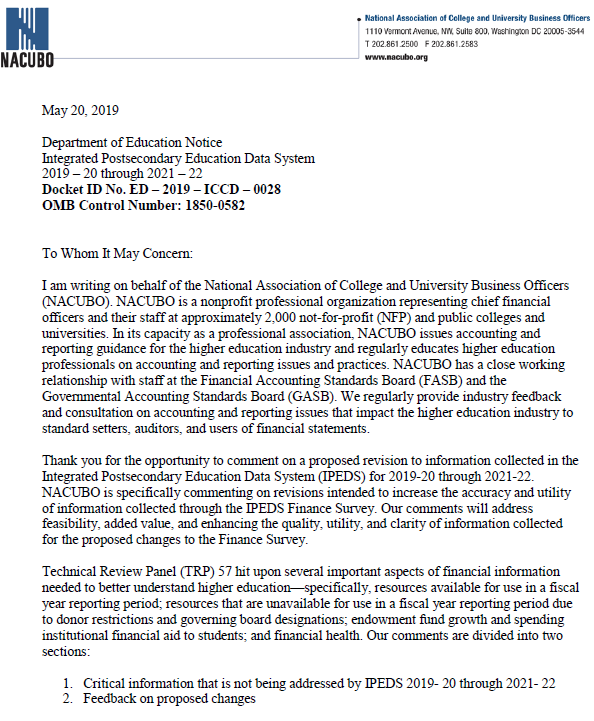
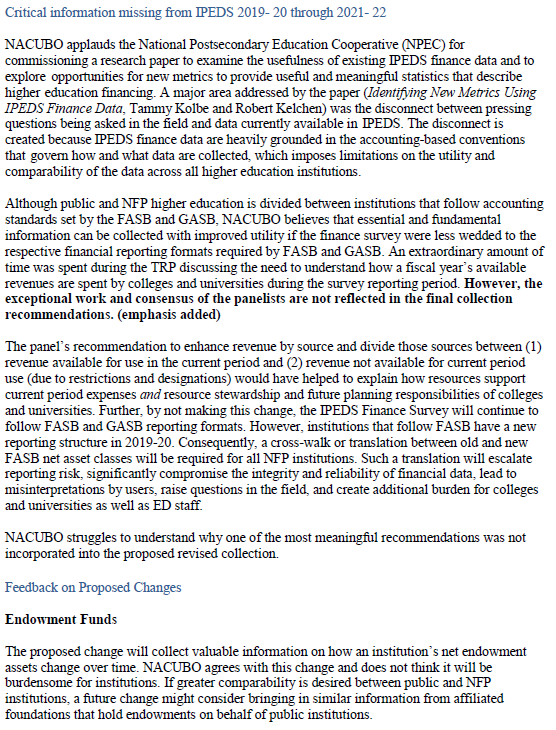

Response – Finance (Comment # 49)
Dear Susan Menditto,
Thank you for your support of many of the proposed changes to the IPEDS Finance survey component.
NCES would like to address your concern regarding the suggestion that IPEDS finance data are heavily grounded in the accounting-based conventions and that the utility of the data would improve if finance survey data “were less wedded to the respective financial reporting formats required by FASB and GASB.” The panelists at TRP # 57 (IPEDS Financial Metrics) discussed possible ways to streamline the survey to improve the comparability across accounting standards; however, panelists suggested that some proposed changes that could potentially enhance accessibility for users would reduce transparency of the data. NCES will engage in continued research and discussion with stakeholders on ways to streamline the survey while maintaining data continuity and transparency.
In response to your comment on collecting data on intercollegiate athletics revenue’s categories, panelists at TRP #57 recommended that NCES collect intercollegiate athletics revenue data in the same way as intercollegiate athletics expenses data.
Thank you for taking the time to provide comment.
Sincerely yours,
Samuel F. Barbett
Acting Postsecondary Branch Chief
Administrative Data Division
Comment on the IPEDS data collection – Reporting for 2-year institutions on EF, GR, and GR200 (Comment # 50)
Document: ED-2019-ICCD-0028-0050
Name: David Mongold
Date posted: May 21, 2019
COMMENT ON REGULATIONS.GOV REGARDING IPEDS DATA COLLECTION
DOCKET ED-2019-ICCD-0028
May 20, 20191
Comment regarding reporting for two-year institutions offering baccalaureate degrees.
1)Part E of the Fall Enrollment Survey
UH Maui College (141839) currently offers 3 baccalaureate degrees. All three are Bachelors in Applied Science (BAS) degrees. To enroll in one of these programs, students are required to have reached upper division standing. With few exceptions, individuals may not be admitted as first-time degree-seeking students. Therefore, in the retention portion (Part E) of the Fall Enrollment survey, the reported cohort number is zero. This has been the case for many years (since the 2009-10 data collection). UH Maui College would like to report retention data for the non-baccalaureate first-time degree-seeking cohorts. Perhaps a screening question could be added to the IC Header that would enable an institution like UH Maui College to select the cohort upon which to report. The question could be nested in Part B.6 of the IC Header. All that would be required would be to add clarification on the level of students enrolled as first-time degree-seeking students. The question is currently worded to lump together all the students at the baccalaureate and below. So, although UH Maui College has first-time degree-seeking students pre-loaded in the IC Header, Part E of the Fall Enrollment survey specifies retention data for Bachelors cohorts. What is requested is to allow the institution to report on the non-baccalaureate degree-seeking cohort, as identified in the IC Header.
2)Cohorts for Graduation Rates Survey
Since UH Maui College offers Bachelors degrees, the cohorts reported for graduation rates are the four-year cohorts. However, as noted, UH Maui College is primarily a two-year institution, and is part of the University of Hawaii Community College system. The other six community colleges in the UH System report on two-year cohorts. UH Maui College would prefer to report on two-year cohorts, so that the reported graduation rates are in alignment with the other community colleges. Again, a simple screening question in the IC Header is all that would be required to correct this problem.
3)Graduation Rate 200 Survey
Since UH Maui College does not have baccalaureate first-time degree-seeking cohorts, there is currently no Graduation Rate 200 survey for the institution. This has been the case since the GRS 200 survey began with the 2009-10 collection. This issue is related to the previous discussion. The Graduation Rate survey allows UH Maui College to report on all undergraduate students, but the Graduation Rate 200 survey does not. Allowing UH Maui College the option to report for non-baccalaureate cohorts would open the Graduation Rate 200 survey.
4)Summary:
In summary, we are requesting three changes:
A)Add a screening question to the IC Header that would clarify the level of the first-time degree-seeking students enrolled at the institution and allow reporting for non-Bachelor cohorts.
B)On the basis of this screening question, change the cohorts reported for the Graduation Rate Survey to the two-year cohorts rather than the four-year cohorts (as currently required). Hopefully this change would also allow the institution to report data for the Graduation Rate 200 survey.
C)On the basis of this screening question, change the retention portion (Part E) of the Fall Enrollment Survey to allow reporting for non-bachelors cohorts.
Response – Reporting for 2-year institutions on EF, GR, and GR200 (Comment # 50)
Dear David Mongold,
IPEDS uses classification variables to divide the universe into institutional groupings to collect and
disseminate IPEDS data. Level of institution (4-year, 2-year, or less-than-2-year), based on the
highest award level offerings reported in the Institutional Characteristics Header (IC-H) file, is a
common factor used in these classification variables. Sector, which is a derived variable by
combining the control of an institution (public, private nonprofit, or public for-profit) with the level
of institution, is used to determine the applicability for IPEDS survey components. Beyond the
reporting ramifications, sector is often used to determine institutional type for IPEDS publications
and consumer information tools.
In many cases the current groupings work as intended, but some institutions do not fall neatly into
one category. A National Postsecondary Education Cooperative (NPEC) working group examined
institutional groupings in IPEDS and prepared an internal paper in (Institutional Grouping
Working Group, Identification of Issues and Recommendations, 2013). The findings suggest that using
sector as a grouping method can be problematic for 2-year institutions with limited baccalaureate
programs. As discussed in the paper, these institutions are grouped with 4-year institutions on the
basis of highest award level offerings but are more like 2-year institutions based on awards actually
conferred during a given academic year. The types of data that are collected as a result of those
groupings may lead to confusion and misinterpretation when data are used for consumer information
or accountability purposes.
The Outcome Measures (OM) survey component is one way that NCES has been able to show a more complete picture of the higher education enrollment and completions of all the students in the United States. A Technical Review Panel (TRP #48, Institutional Groupings) held in October 2015 proposed a number of other solutions, many of which were similar to your proposed solutions. NCES investigated the potential solutions and none of the solutions were implemented. The potential solutions created complicated reporting issues such as increased burden and misunderstanding of requirements leading to inaccurate reporting, as well as dissemination issues and the loss of ability to use the data for national statistics and institutional comparisons.
NCES plans to continue to investigate ways to improve the collection of data from institutions that do not fit into the traditional level/sector designations.
Thank you for taking the time to provide comment.
Sincerely yours,
Samuel F. Barbett
Acting Postsecondary Branch Chief
Administrative Data Division
Comment on the IPEDS data collection – Outcome Measures and Finance (Comment # 58)
Document number: ED-2019-ICCD-0028-0058
Name: Kody Carmody
Date posted: May 21, 2019
The attached letter contains comments from Bipartisan Policy Center staff regarding potential changes to IPEDS [Docket No. ED-2019-ICCD-0028]. If you have any questions about these comments, please contact Kody Carmody, a Research Analyst with BPC's Economic Policy Project (kcarmody@bipartisanpolicycenter.org).
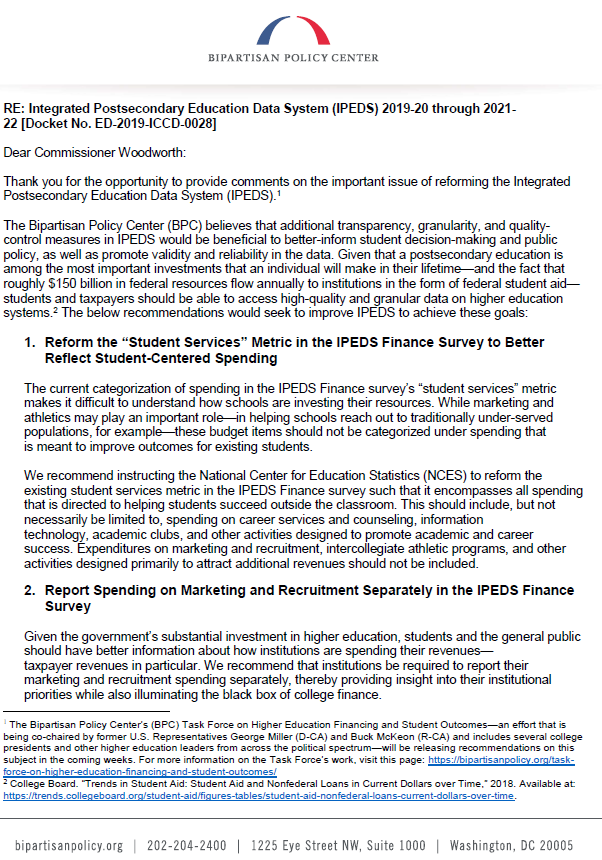

Response – Outcome Measures and Finance (Comment # 58)
Dear Kody Carmody,
NCES appreciates your suggestions to reform the “student services” metric to better reflect student-centered spending and to report spending on marketing and recruitment separately. During some of our discussions with experts, this topic was brought up and the feedback we have received is that this will require further research and discussion with stakeholders to properly collect these data while ensuring the data collected are of high quality and the reporting of the data is not overly burdensome to institutions.
To address your specific comment related to the Outcome Measures (OM) and Graduation Rates (GR) survey components, the purpose of the OM survey component is to address the limitations of the GR survey component. The collection of graduation rates is defined by statute (Student Right to Know and Campus Security Act) and restricted to data collection on first-time, full-time undergraduate students that enter in a Fall term, or its equivalent. The OM survey is not defined similarly and thus, NCES cannot fold the GR into the OM survey component. Furthermore, OM provides the opportunity to follow the original recommendations of the 2012 Committee on Measures of Student Success, which were to broaden the coverage of student graduation data to reflect a more diverse student population at two-year institutions and improve the collection of the overall student progression and completion data. With this purpose in mind, OM allows for a more complete collection on graduation rates by instructing academic reporters to report on a full year student cohort instead of a Fall census-based cohort. This decision was greatly supported by the several data users of researchers and policy analysts (refer to 2016-2019 IPEDS OMB 60-day and 30-day public comment periods ID: ED-2016-ICCD-0020-0001 and ID: ED-2016-ICCD-0020-0068). The proposed changes would allow for the inclusion of more students in Outcome Measures, particularly students that enroll in the Spring that have not been included in prior cohorts. The NCES chose a July 1 start for the OM full-year entering cohort because it aligns with the 12-month Enrollment Survey (E12) component that begins its reporting period of July 1 through June 30 as well as with the Federal Student Aid (FSA) practice of awarding of student aid starting in July 1. IPEDS Enrollment data are used as data quality assurance checks for data reported to OM, which is the reason NCES is proposing adding the disaggregations to 12 Month Enrollment (E12) in this OMB clearance package.
To your suggestions on tightening data definitions and creating formal auditing process, NCES continues to improve survey instrumentation, including making improvements to definitions and instructions through engaging various stakeholders in meaningful discussions. In addition, NCES employs a variety of quality check procedures to ensure data reliability (for example, adding the E12 disaggregations mentioned in the previous paragraph in order to control check OM). In addition, the public nature of the IPEDS data provides a strong reason for institutions to report accurately to the IPEDS. NCES does not have the mandate at this time to audit IPEDS data.
Thank you for taking the time to provide comment.
Sincerely yours,
Samuel F. Barbett
Acting Postsecondary Branch Chief
Administrative Data Division
Comment on the IPEDS data collection – Distance Education and Experimental Pell (Comment # 60)
Document: ED-2019-ICCD-0028-0060
Name: Matthew Case
Date posted: May 21, 2019
Please
see the attached comments on the IPEDS Information Collection
Notice.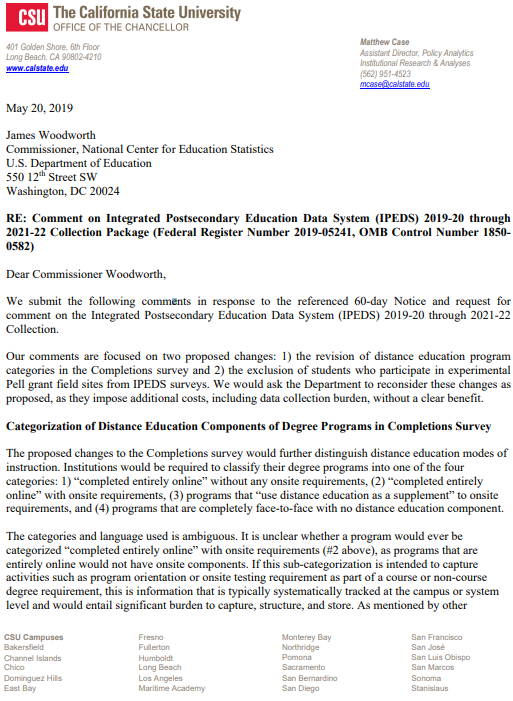

Response – Distance Education and Experimental Pell (Comment # 60)
Dear Matthew Case,
The changes NCES is proposing for the Completions component are based on Technical Review Panel #53, Evaluating Distance Education Elements in the IPEDS Data Collection. The TRP discussed a number of options for improving the collection of distance education data. Other options for improving the collection of distance education in Completions were discussed, however, the panelists did not favor any of the options presented (such as collecting for multiple programs under one CIP code). The question NCES is proposing will provide more information to students and researchers to help them better understand whether the CIP code includes distance education opportunities and whether all programs under the CIP will include distance opportunities, however, they will still need to look into the programs further to find out more information. College Navigator is meant to be a first step, not a final step, in understanding opportunities at institutions.
NCES understands your concerns related to Experimental Pell, however, it is not the case for all institutions participating in Experimental Pell that only 30 of 25,000 students are participating in this program. NCES has received numerous questions from institutions about how to handle Experimental Pell students and has consistently provided the guidance not to include these students. The FAQ NCES is proposing to add is simply making the current policy formalized and public.
Thank you for taking the time to provide comment.
Sincerely yours,
Samuel F. Barbett
Acting Postsecondary Branch Chief
Administrative Data Division
Comment on the IPEDS data collection – Finance (Comment # 59)
Document: ED-2019-ICCD-0028-0059
Name: Anonymous
Date posted: May 21, 2019
Agree with adding disclosures for OPEB. Financial ratios should exclude GASB 68 and 75 since some public institutions do not have to record the liability or it is left at system level. Peer comparisons between institutions will not be meaningful unless you exclude these. Reporting the discounts between tuition and fees and auxiliaries by grant type will be a significant workload.
Response – Finance (Comment #59)
Dear Anonymous,
In response to your comment on financial ratios, IPEDS Finance survey forms include specific instructions to exclude net pension or net other postemployment benefits (OPEB) liabilities/assets from the Financial Health Ratios part that is intended to collect the numerator and denominator used to calculate financial health ratios composing the Composite Financial Index (CFI).
Regarding your comment on reporting the details about sources of discounts and allowances, NCES agrees that this change will result in an increased burden. NCES anticipates a moderate increase in burden, especially in the first year. NCES currently collects the portion of revenues coming from financial aid sources and the goal of this change is to understand how financial aid sources contribute to the institutional revenues and scholarship discounts.
Thank you for taking the time to provide comment.
Sincerely yours,
Samuel F. Barbett
Acting Postsecondary Branch Chief
Administrative Data Division
Comment on the IPEDS data collection – Finance (Comment # 55)
Document: ED-2019-ICCD-0028-0055
Name: Phillip McCarthy
Date posted: May 21, 2019
Pension question Revised screening question to add defined benefit pension or postemployment benefits other than pension (OPEB) liabilities. I believe we would answer no.
Part M Include new data elements to collect data on pension and postemployment benefits other than pension (OPEB). We dont currently do part M, but I believe with these changes we would have to input OPEB expense, Net OPEB liability and deferred inflows and outflows. These amounts should be fairly easy to break out.
Athletics New screening question to determine where/whether institutions will report intercollegiate athletics revenues. We believe these questions would be easy enough to answer.
Part N (ratios) Add a new screen (Part N) to collect numerator and denominator for calculating financial health ratios. We currently have concerns about the IPEDS ratios being different than what is used for the HLC. So, in the case of universities with systems the calculation ignores any revenue/assets of the system. In cases like Penn State who reports all financial data at their main campus, the individual universities will not have calculated ratios. Organizational structure and the way IPEDS is reported would drive the calculation. This is fine for stand-alone universities, but for us, it is problematic.
Part E2 Add a new screen to collect sources of discounts and allowances. Im sure we could come up with a way to accomplish this, however it would be a significant amount of work to obtain the granular level of detail as suggested. To further complicate matters, we use the Alternate Method as outlined in the 2000-05 NACUBO report, which is a theoretical calculation of the discount (and also depends on the amount of refunds issued to students). This change suggested would require us to allocate the theoretical discount across all financial aid sources within the calculation. Im not sure how we would do this. We could come with a way, but when using the alternative method Im not sure how much value it provides. If the objective is to understand the tuition and financial aid made available for comparative purposes, then providing gross values for each would be significantly easier and accomplish the same objective.
Part H Collect market value for change in value of endowment net assets. Dont believe this change would be a problem.
Response – Finance (Comment #55)
Dear Phillip McCarthy,
Thank you for your feedback in letting NCES know where your institutions may or may not have difficulty reporting. Below, please see the NCES response to your concerns in #4 and #5.
To your concern regarding the financial health ratios, NCES understands that the organizational structure of the institutions is significant, and if an institution is a parent institution then the amounts reported should include all of the child institutions.
In response to your comment on collection of sources of discounts and allowances, the goal of the change is to understand how financial aid sources contribute to the institutional revenues and scholarship discounts, thus, NCES is interested in expanding the Scholarship and Fellowship screen beyond collection of the portion of revenues coming from financial aid sources.
Thank you for taking the time to provide comment.
Sincerely yours,
Samuel F. Barbett
Acting Postsecondary Branch Chief
Administrative Data Division
| File Type | application/vnd.openxmlformats-officedocument.wordprocessingml.document |
| Author | Lawley, Tara |
| File Modified | 0000-00-00 |
| File Created | 2021-01-15 |
© 2025 OMB.report | Privacy Policy